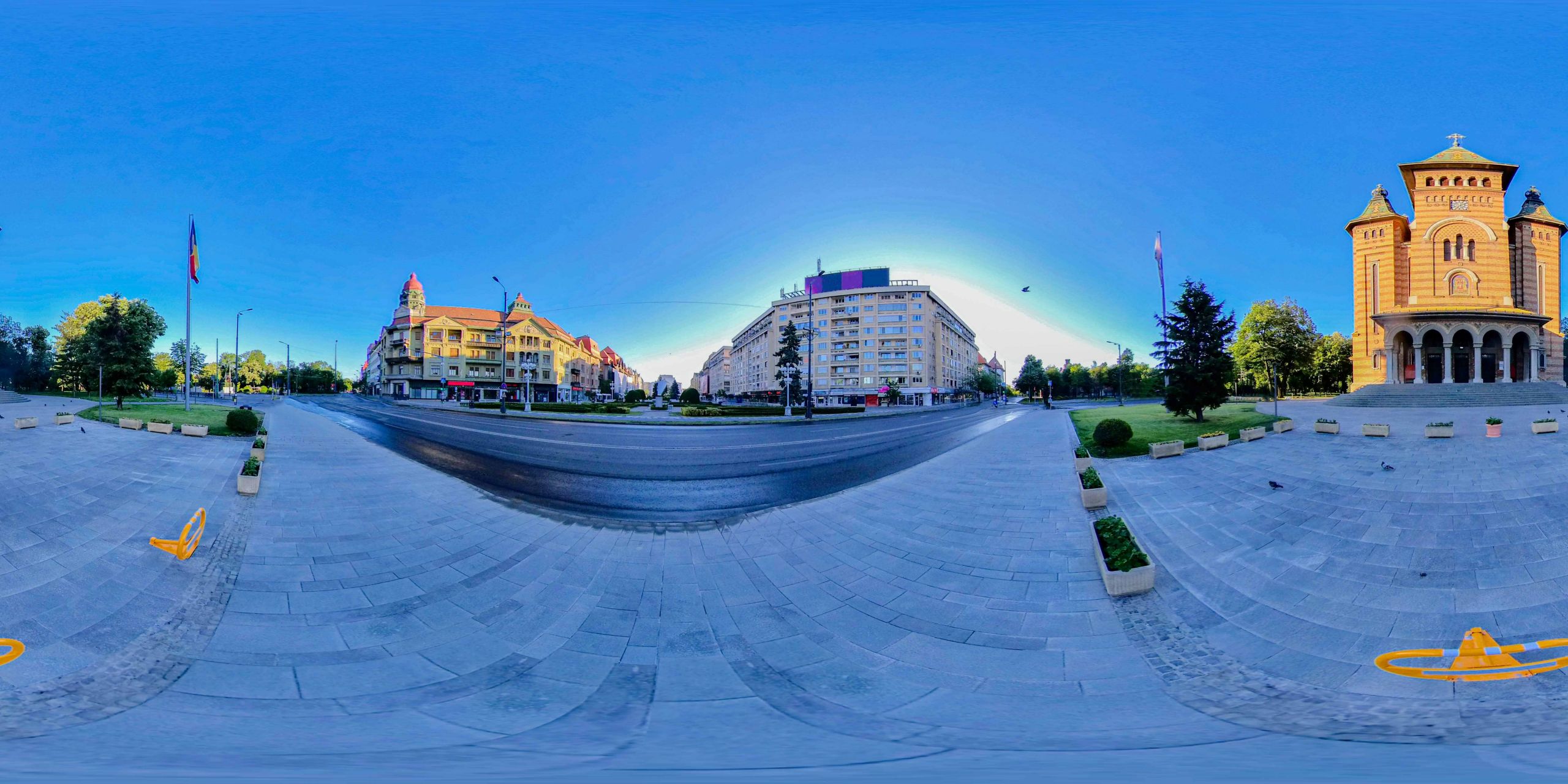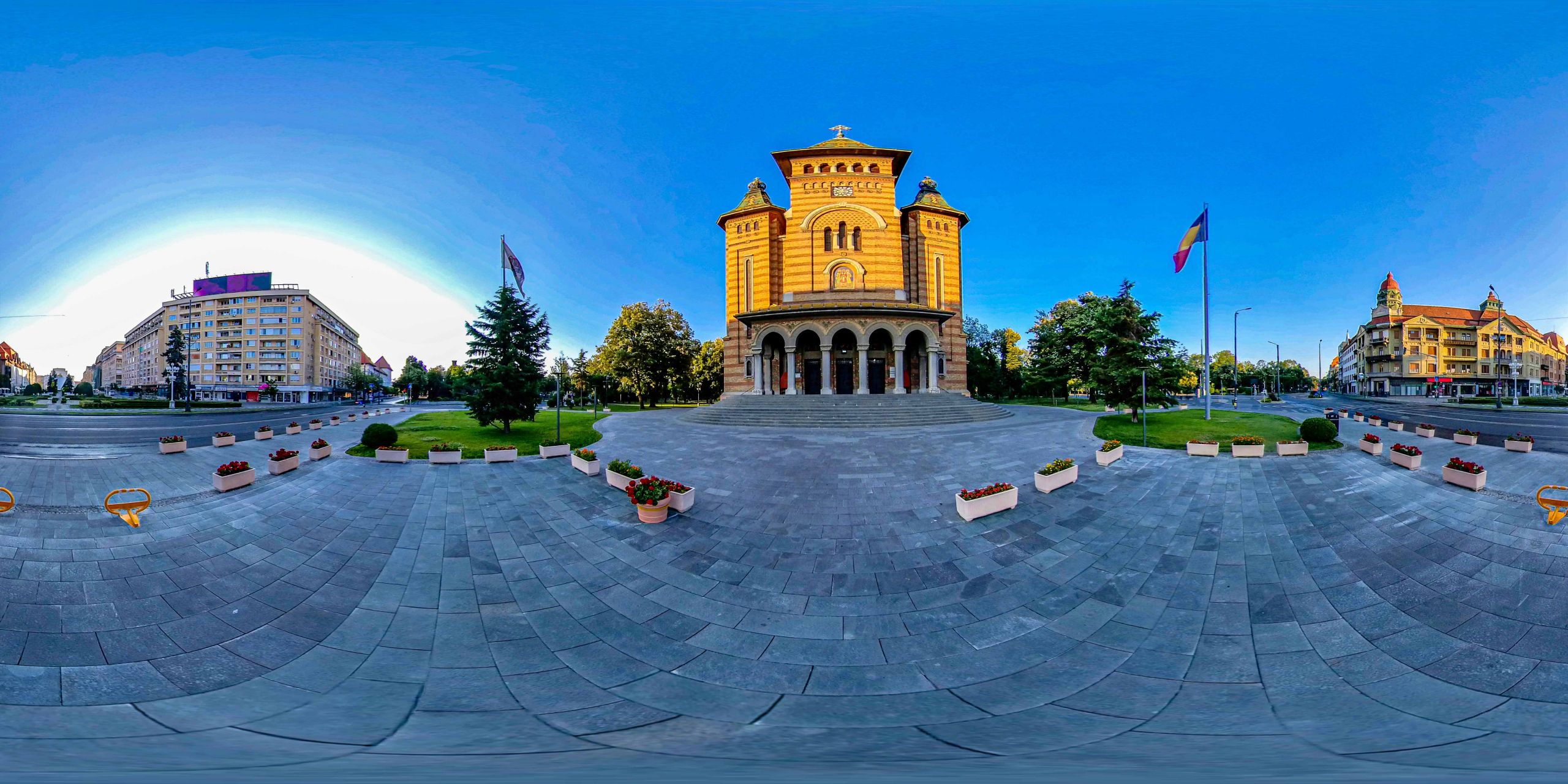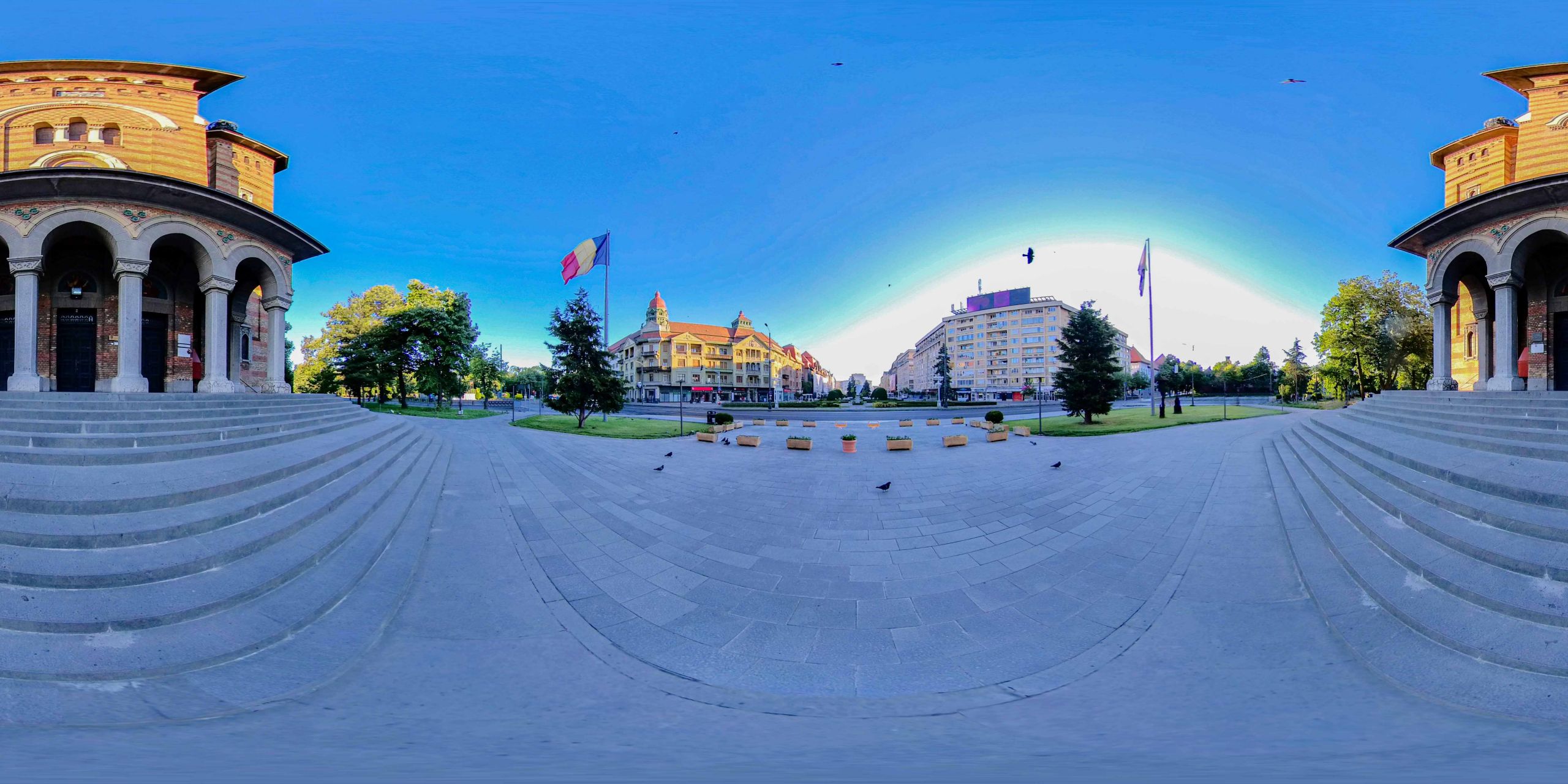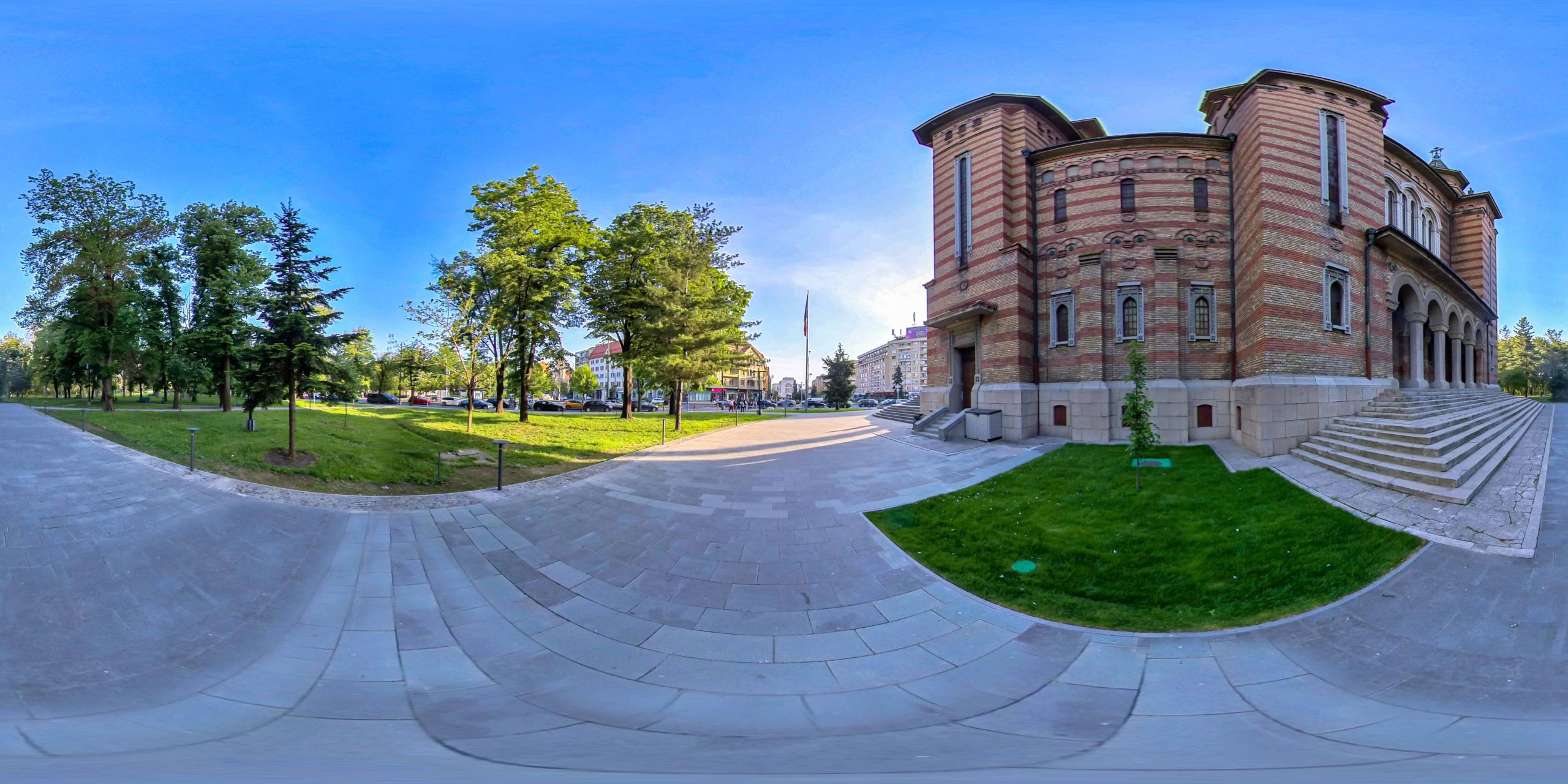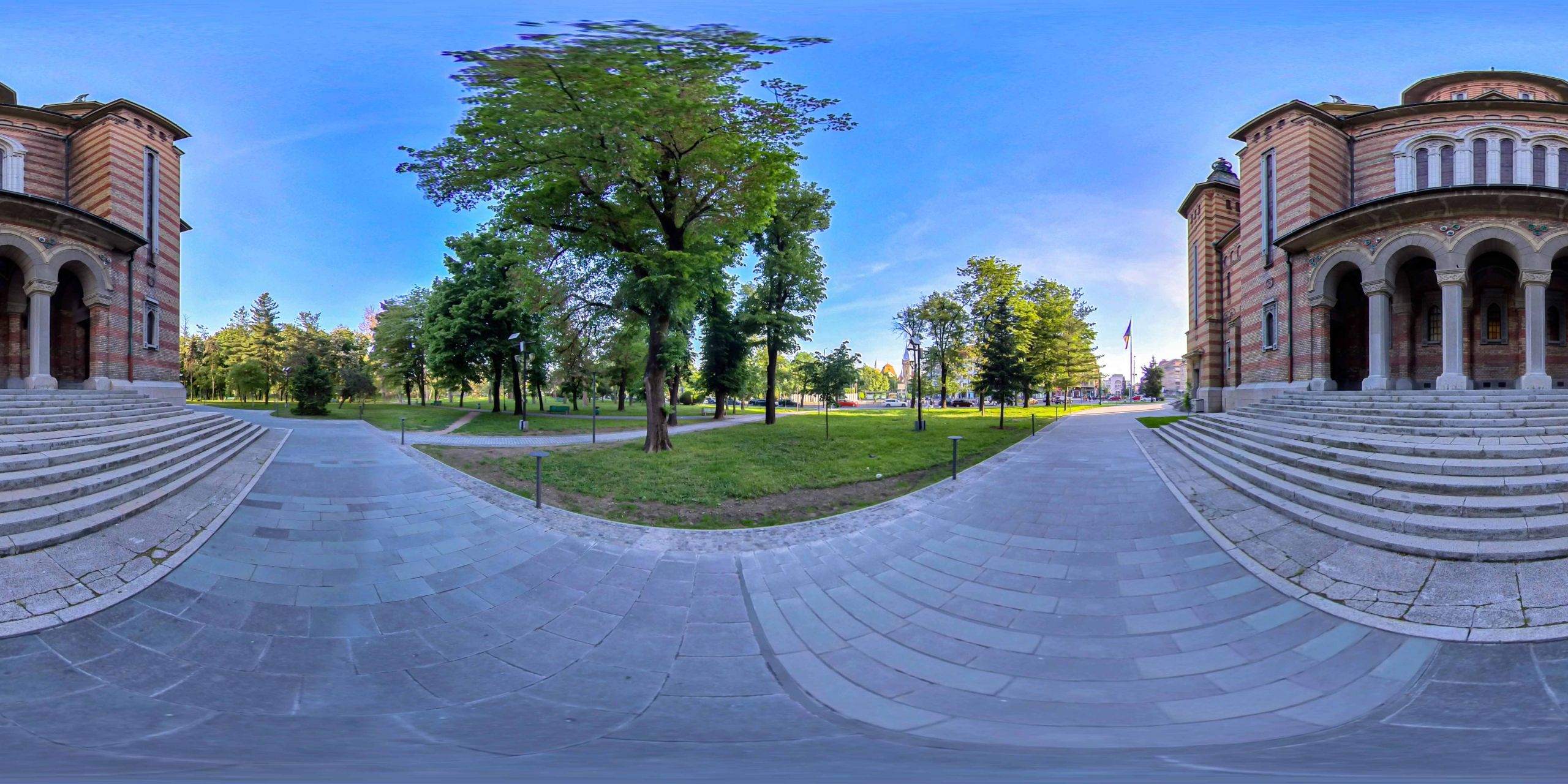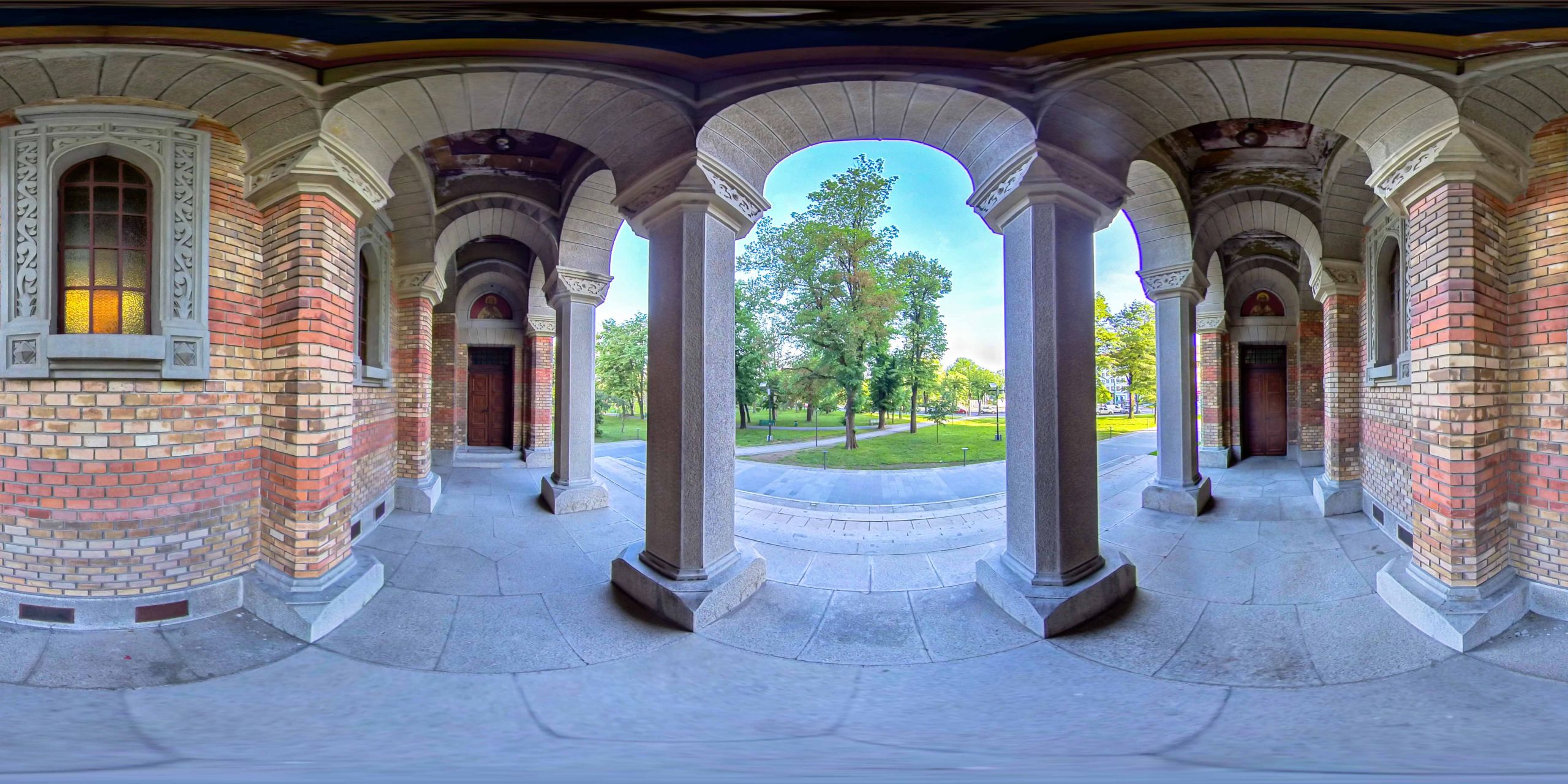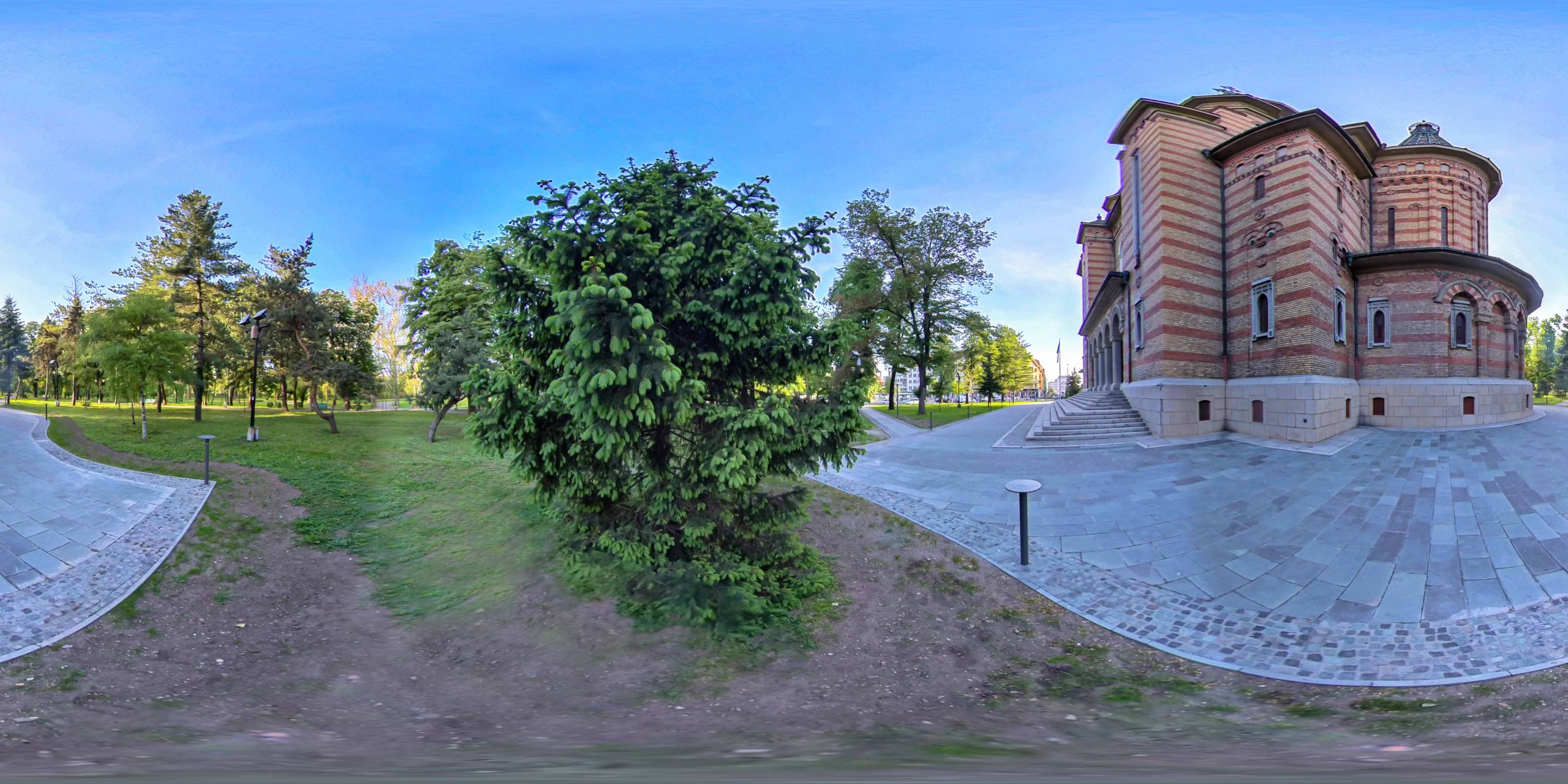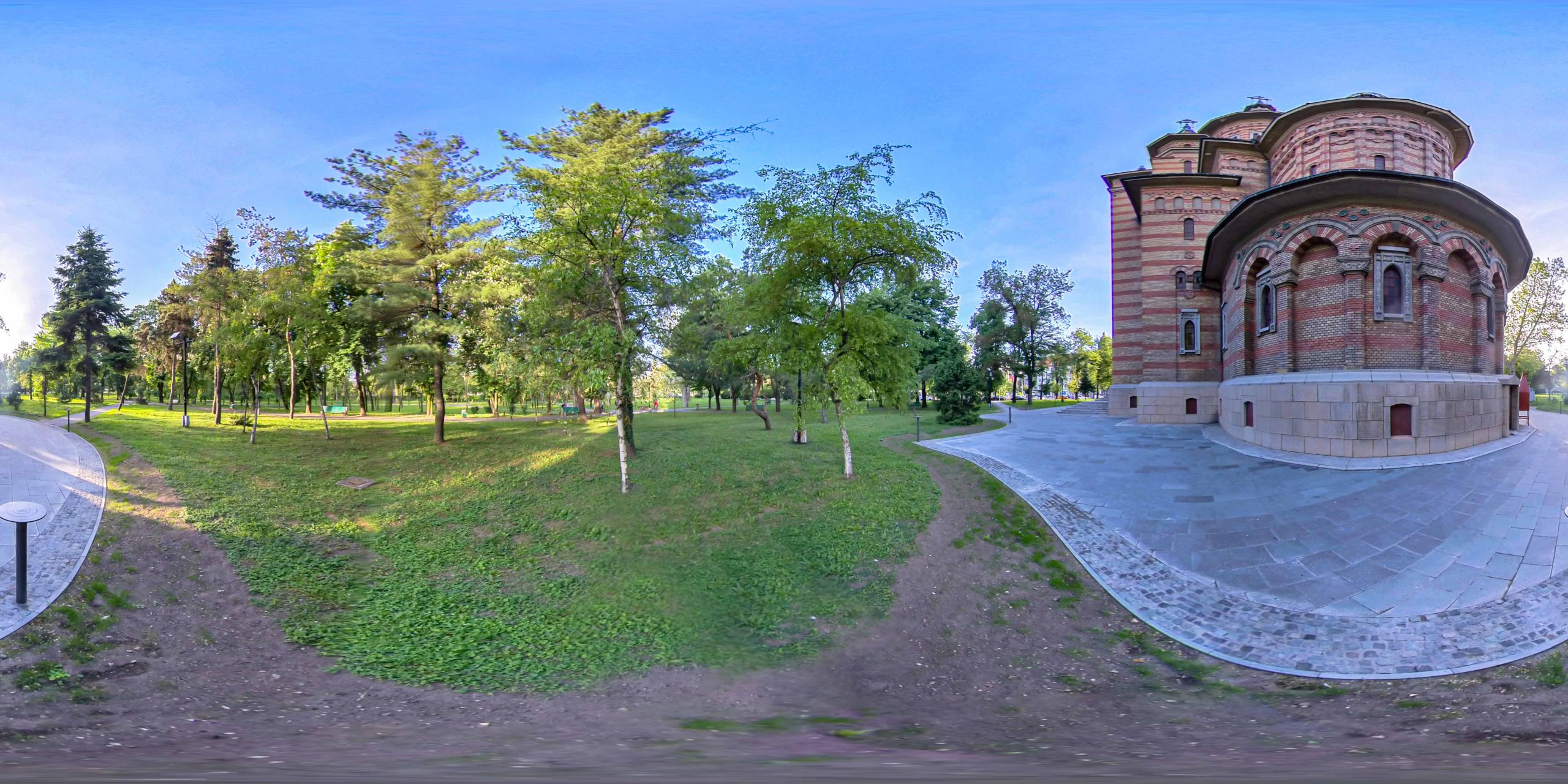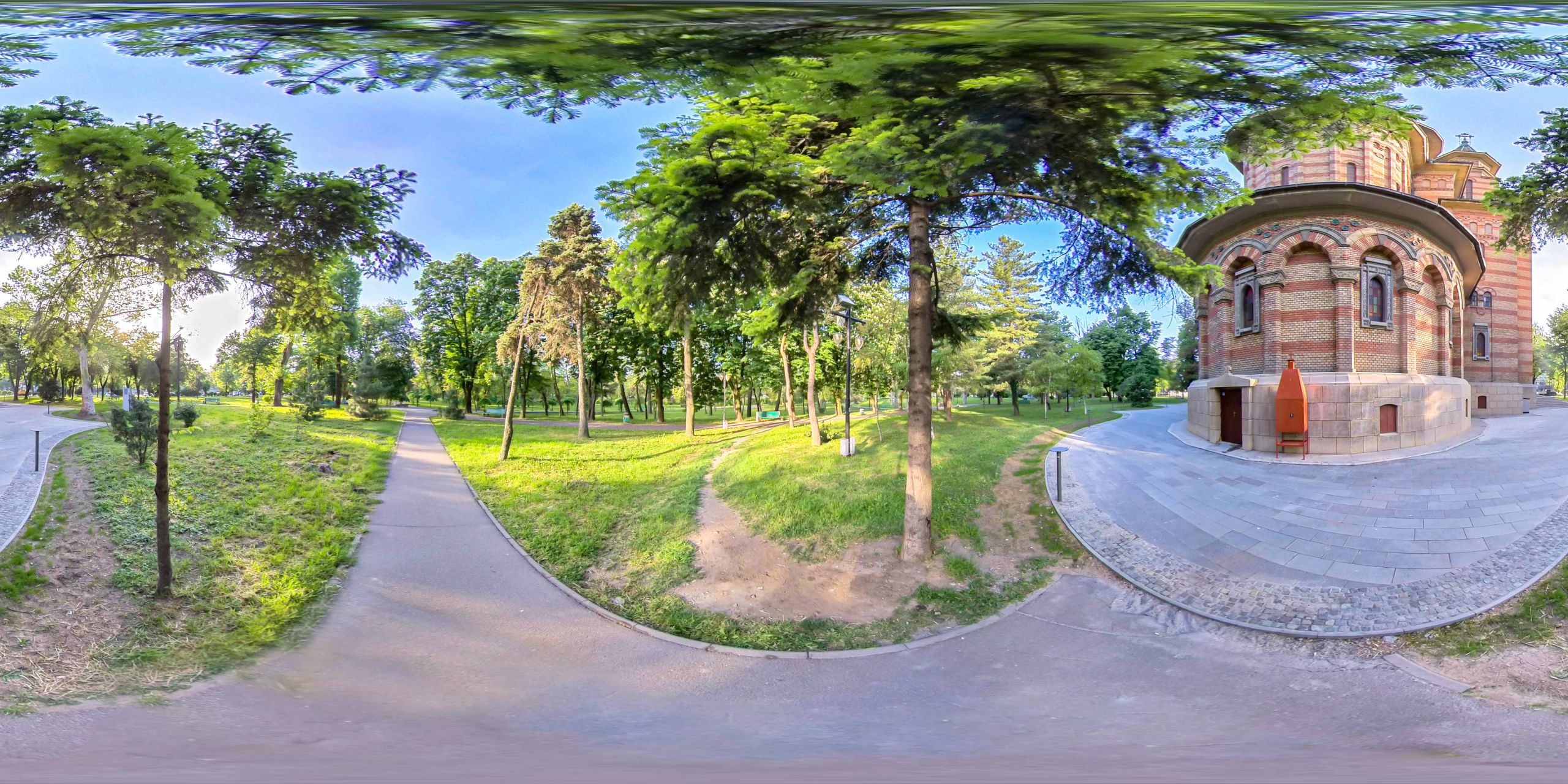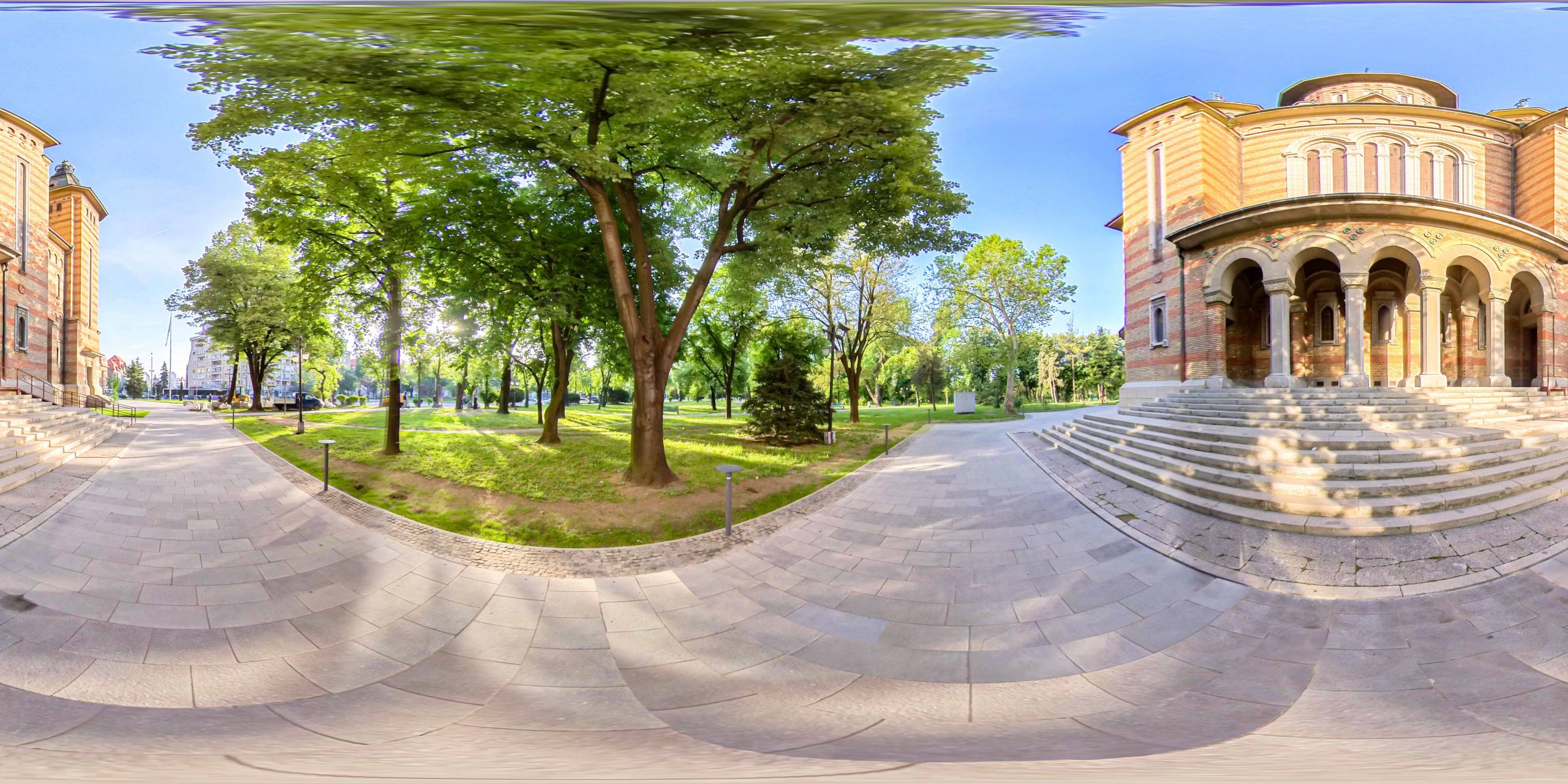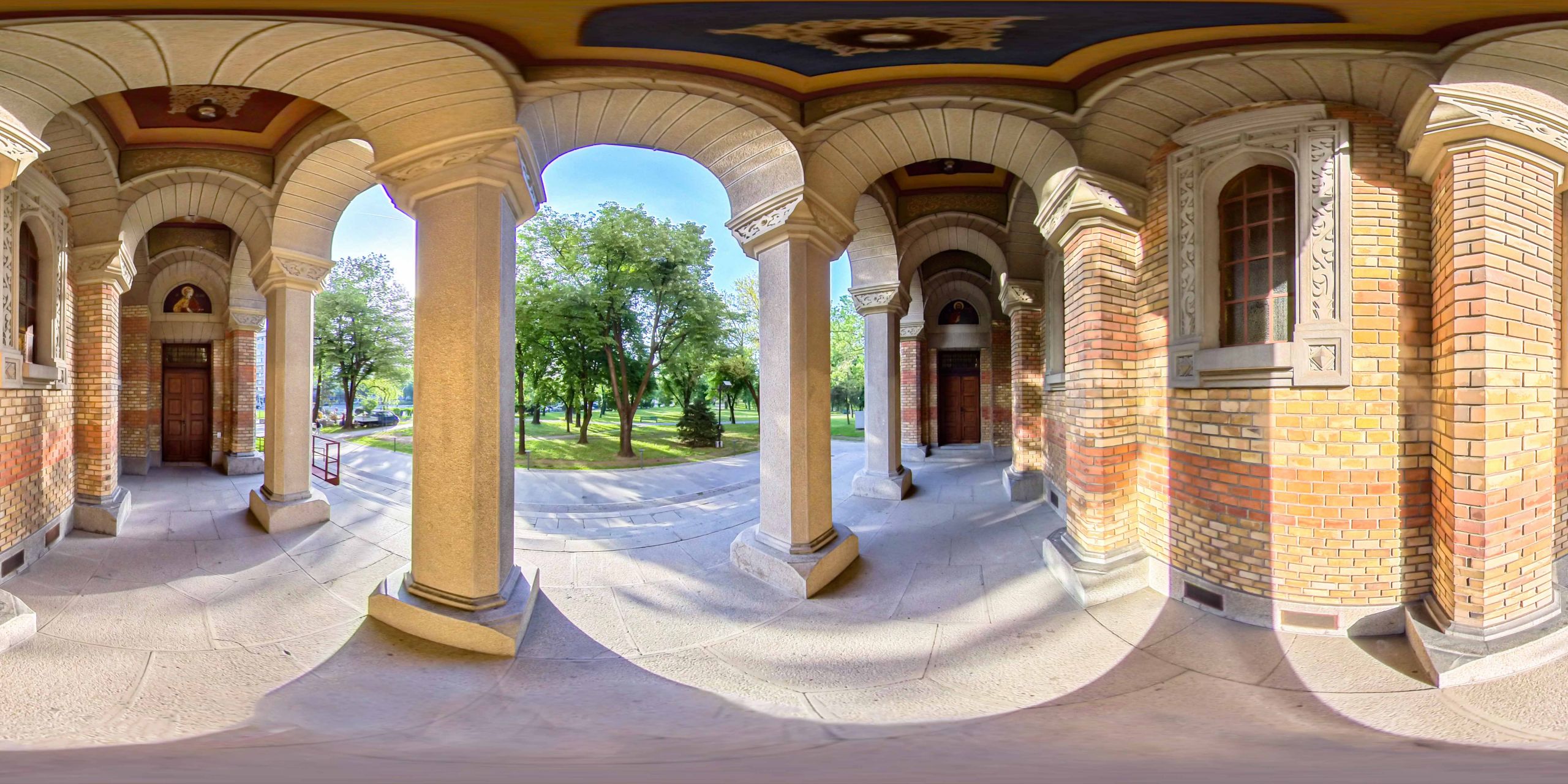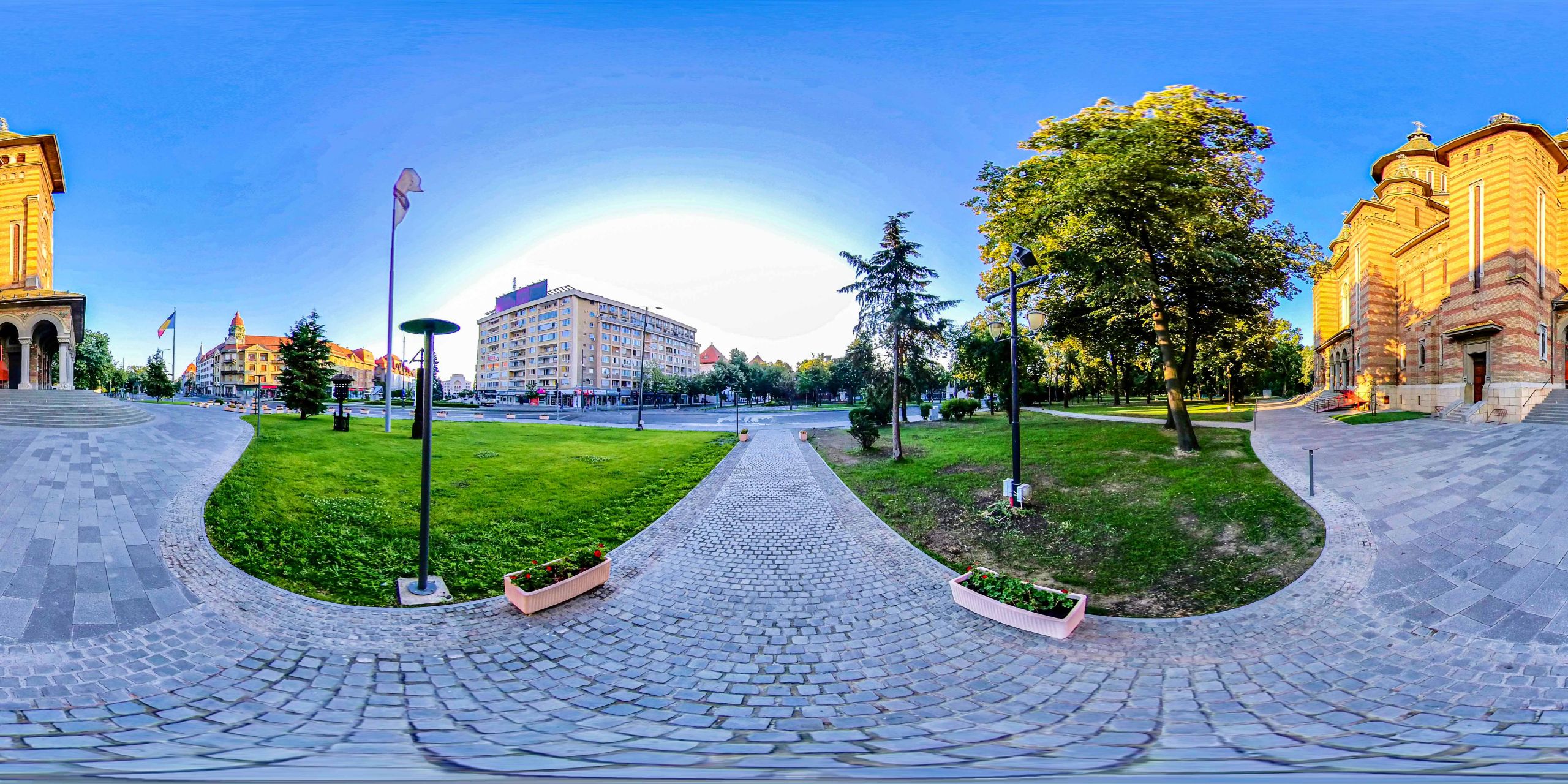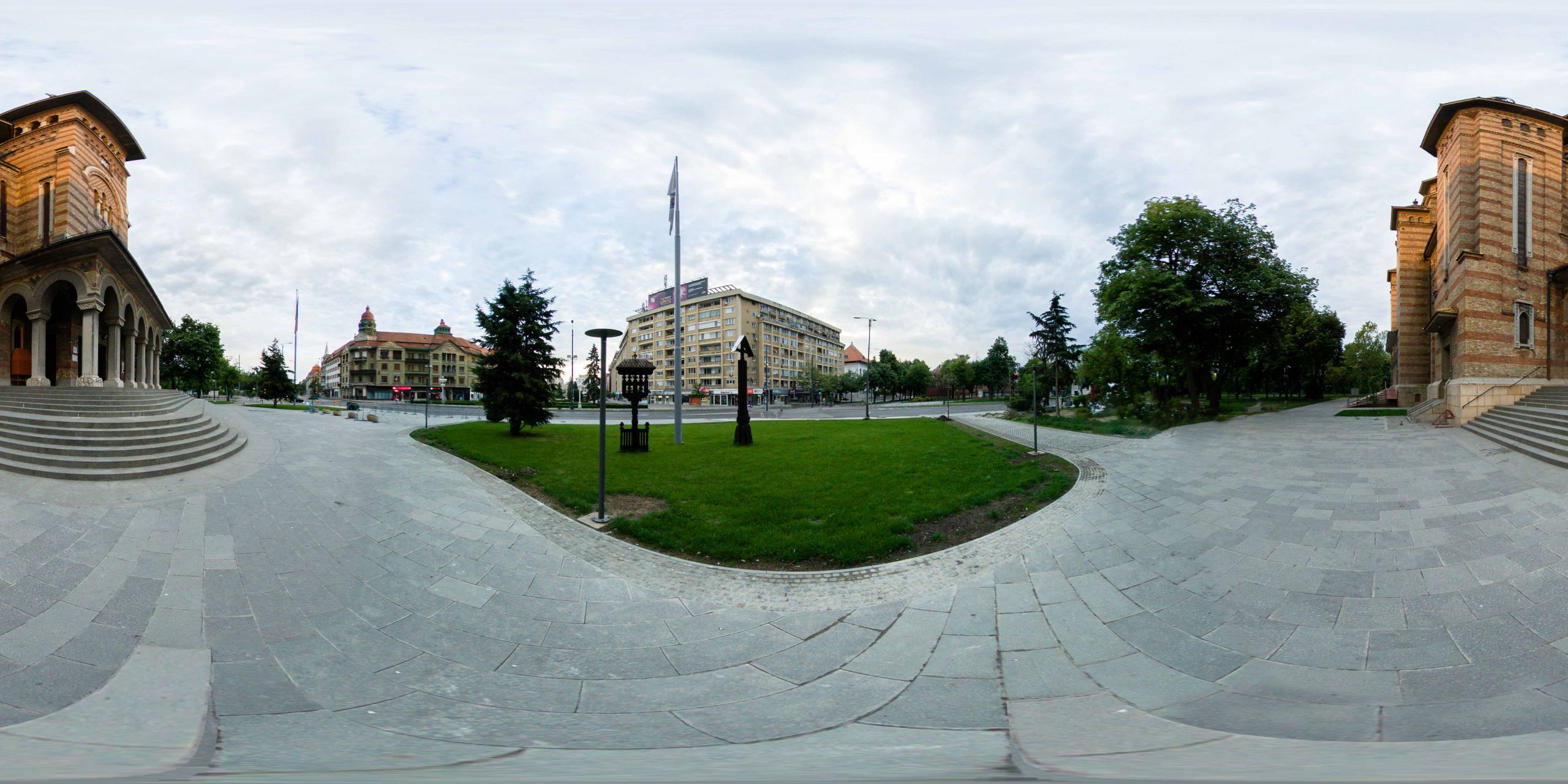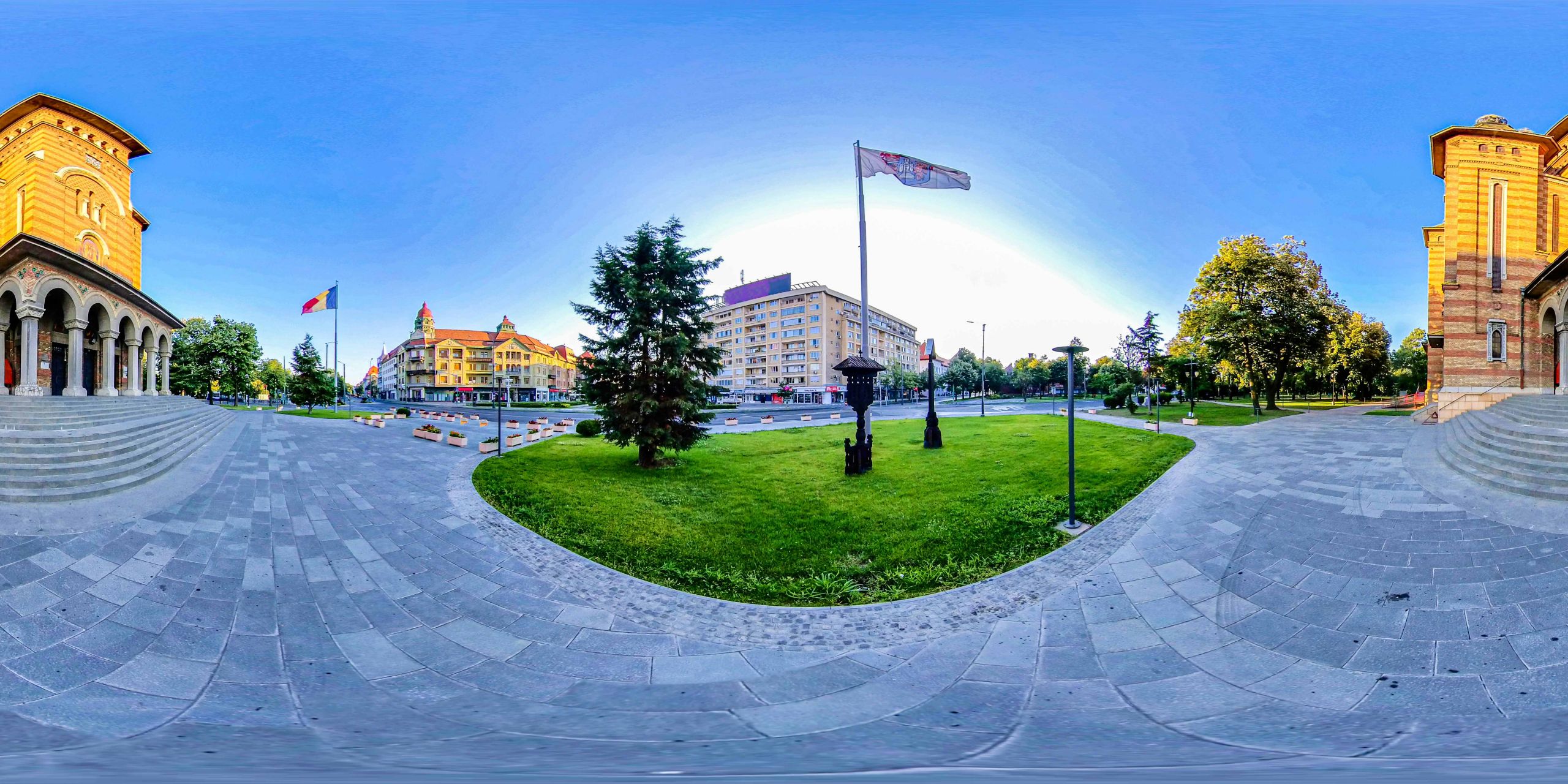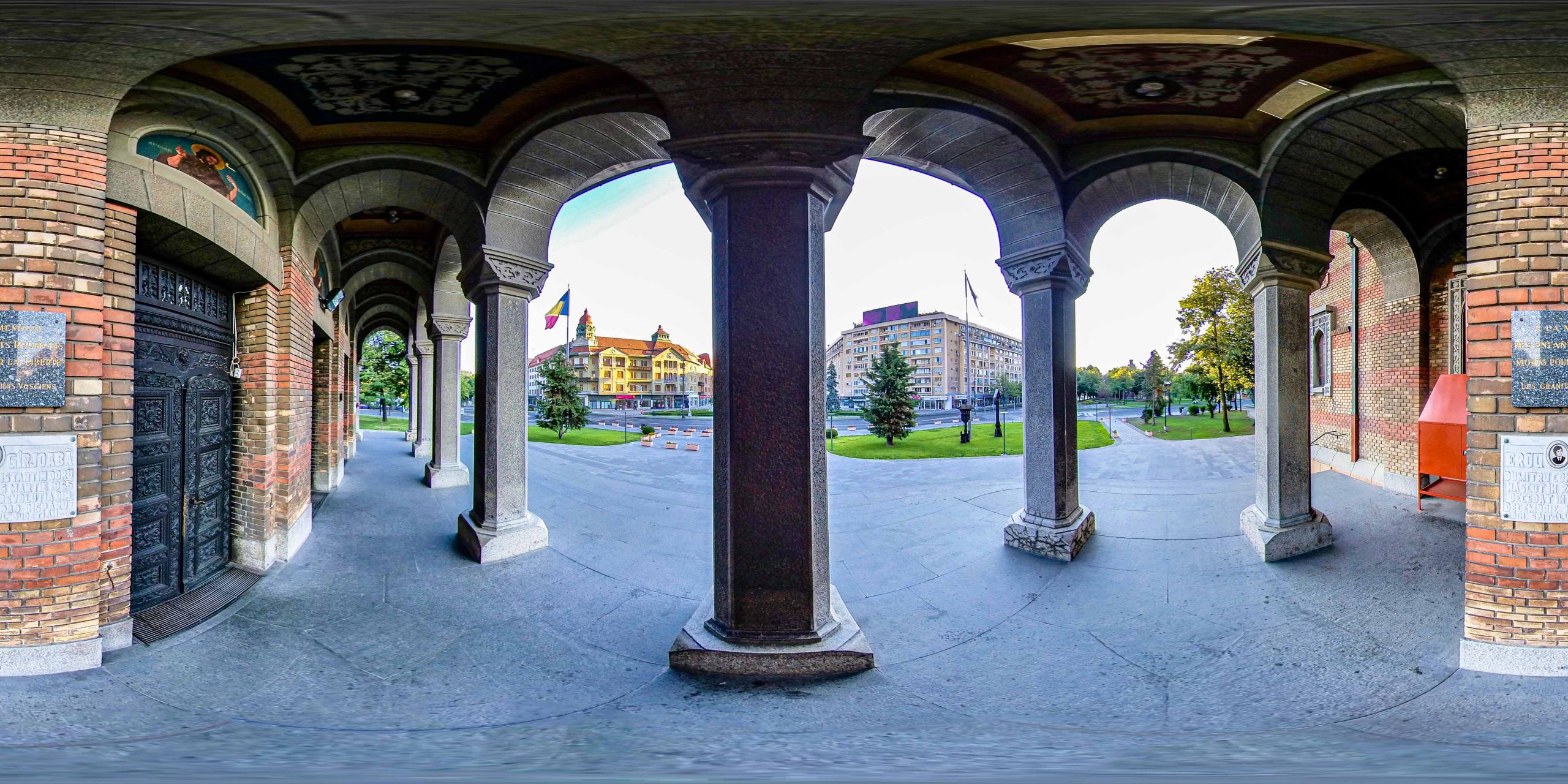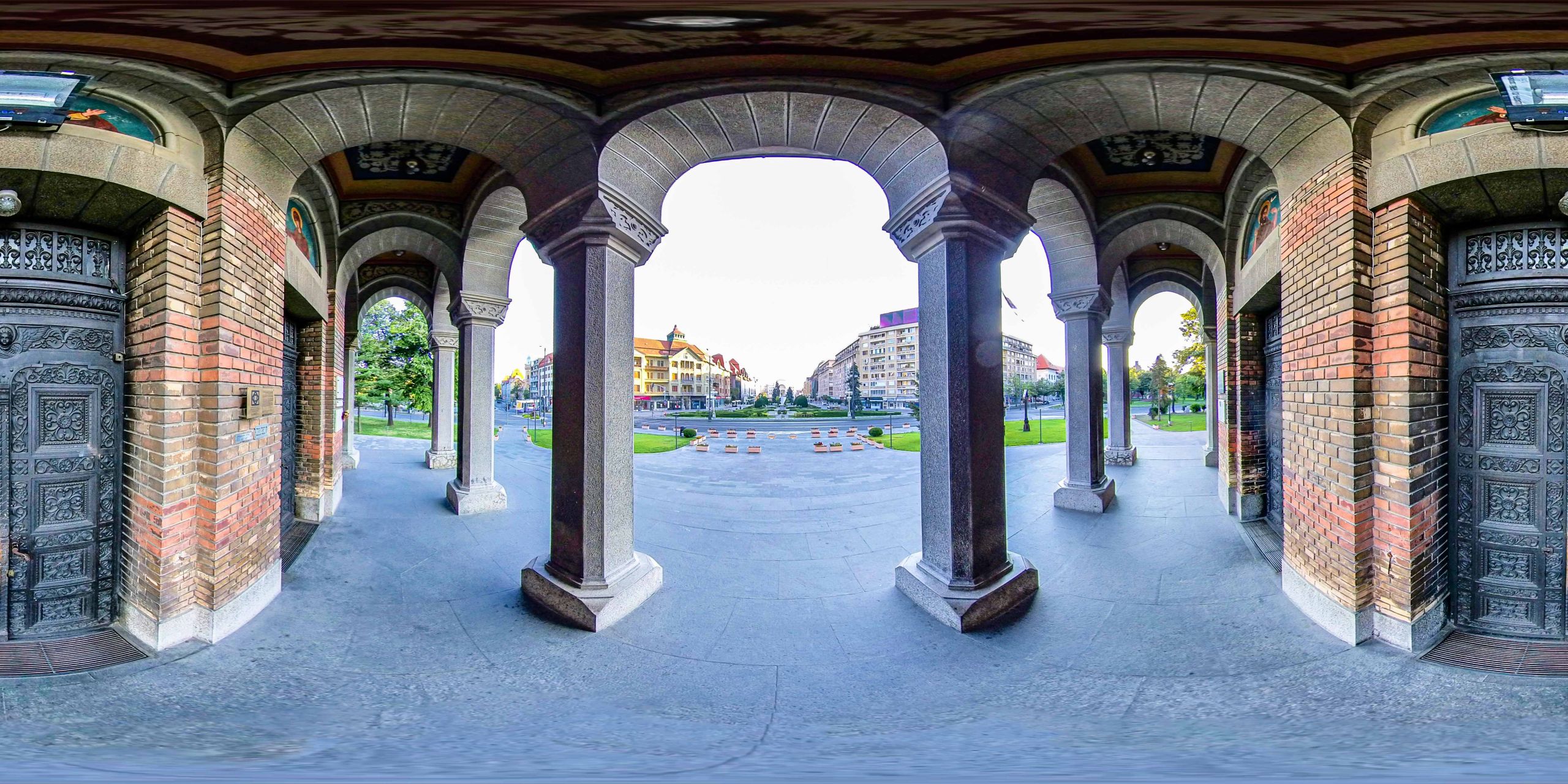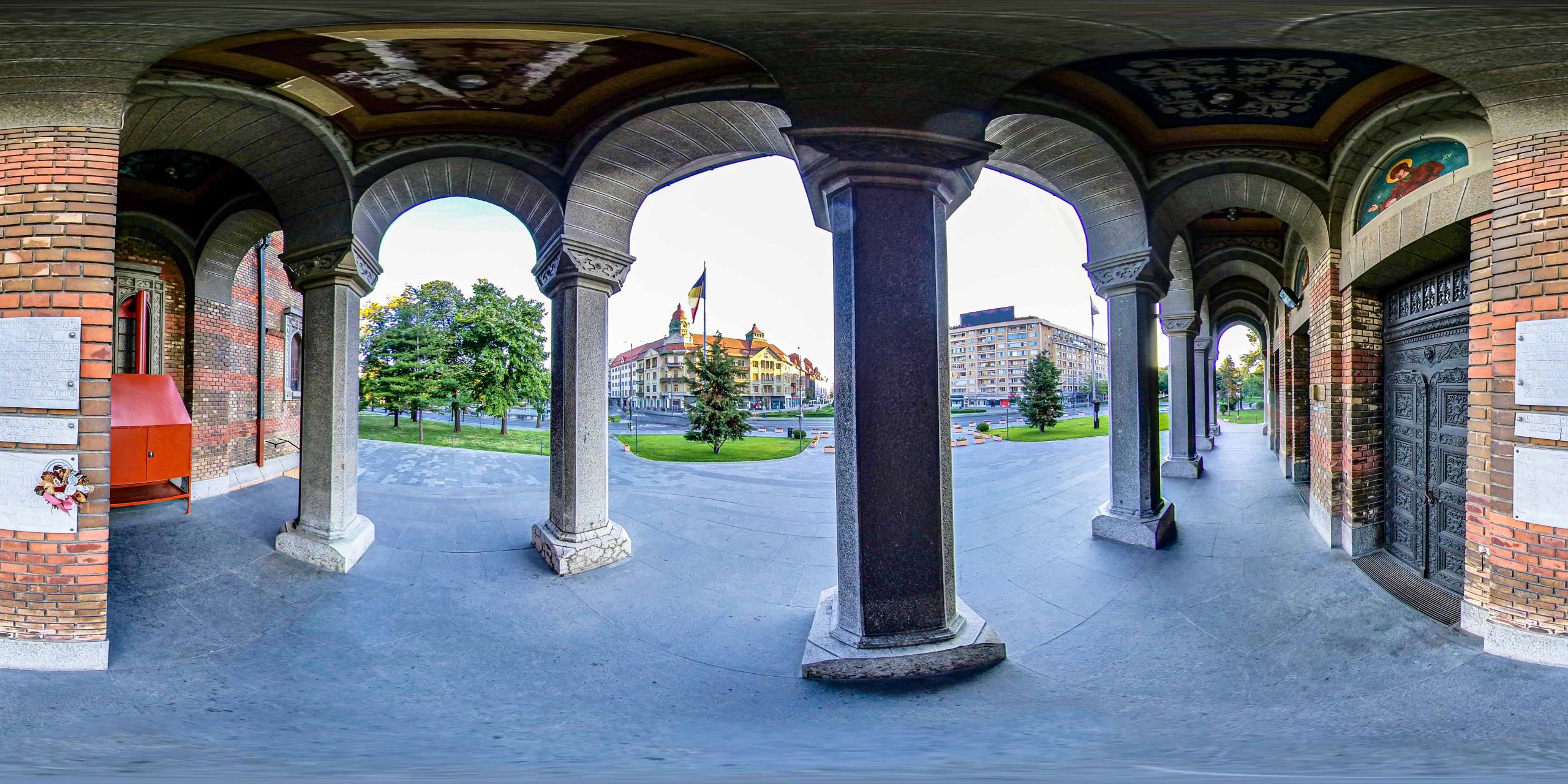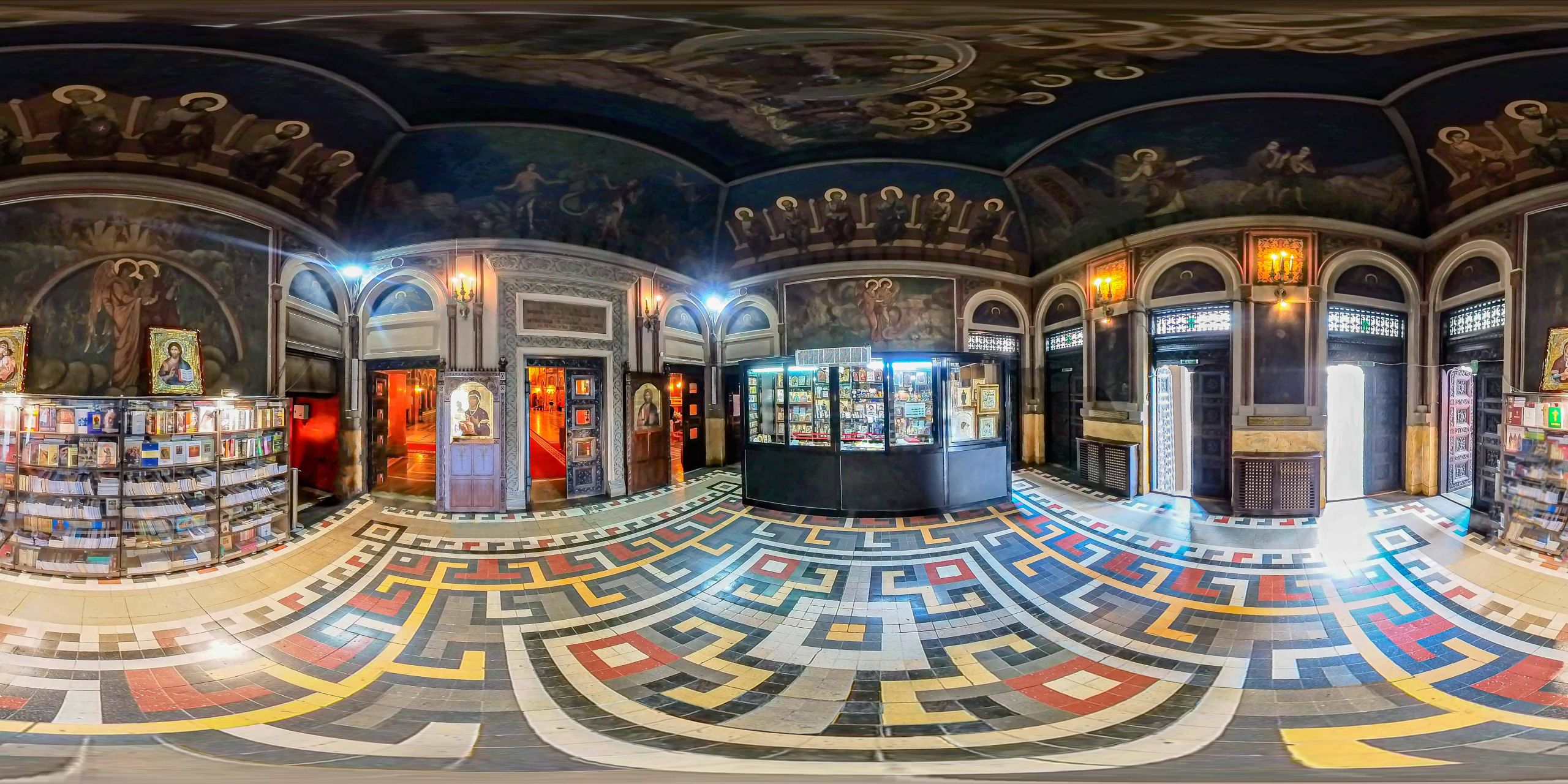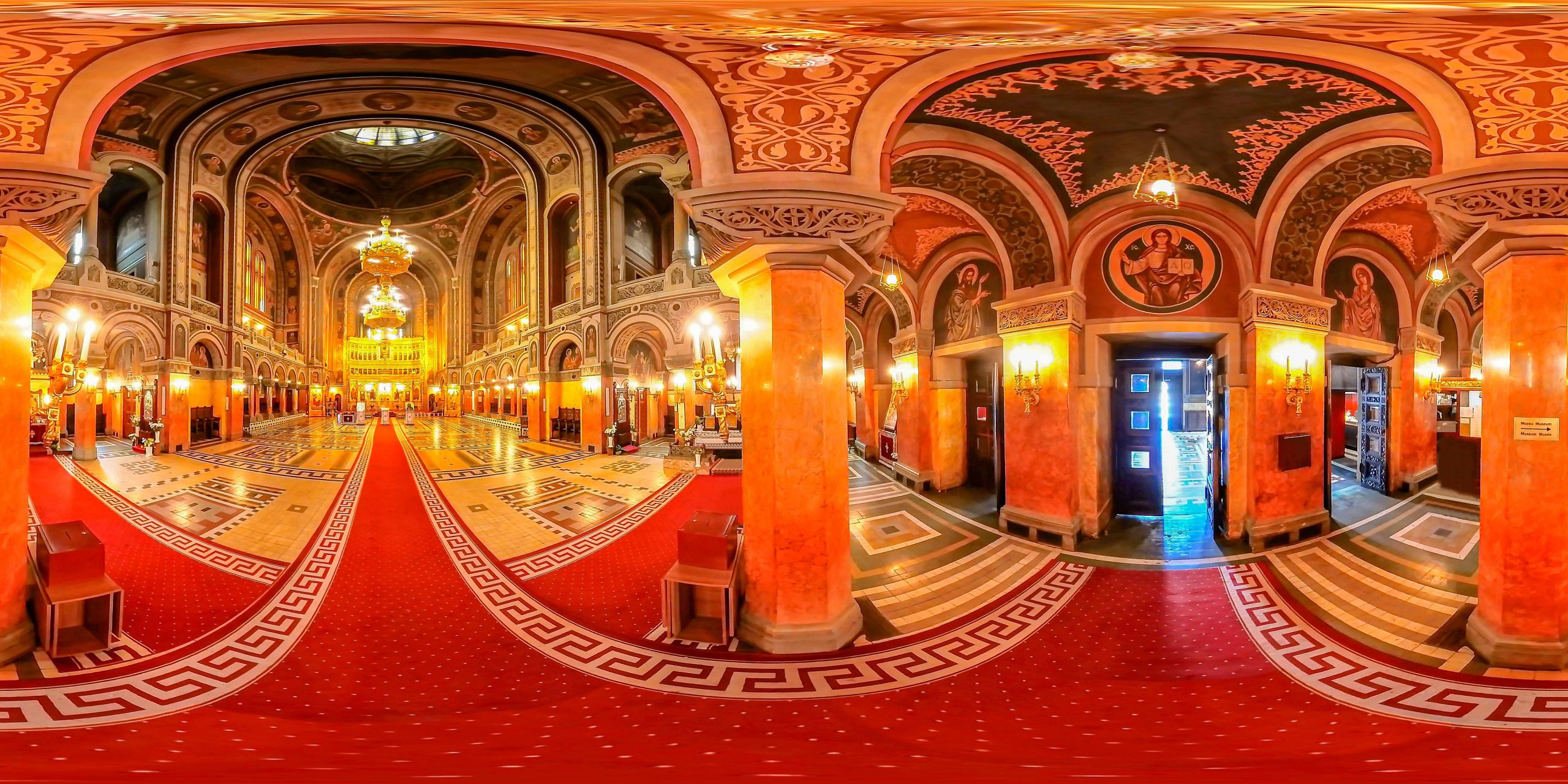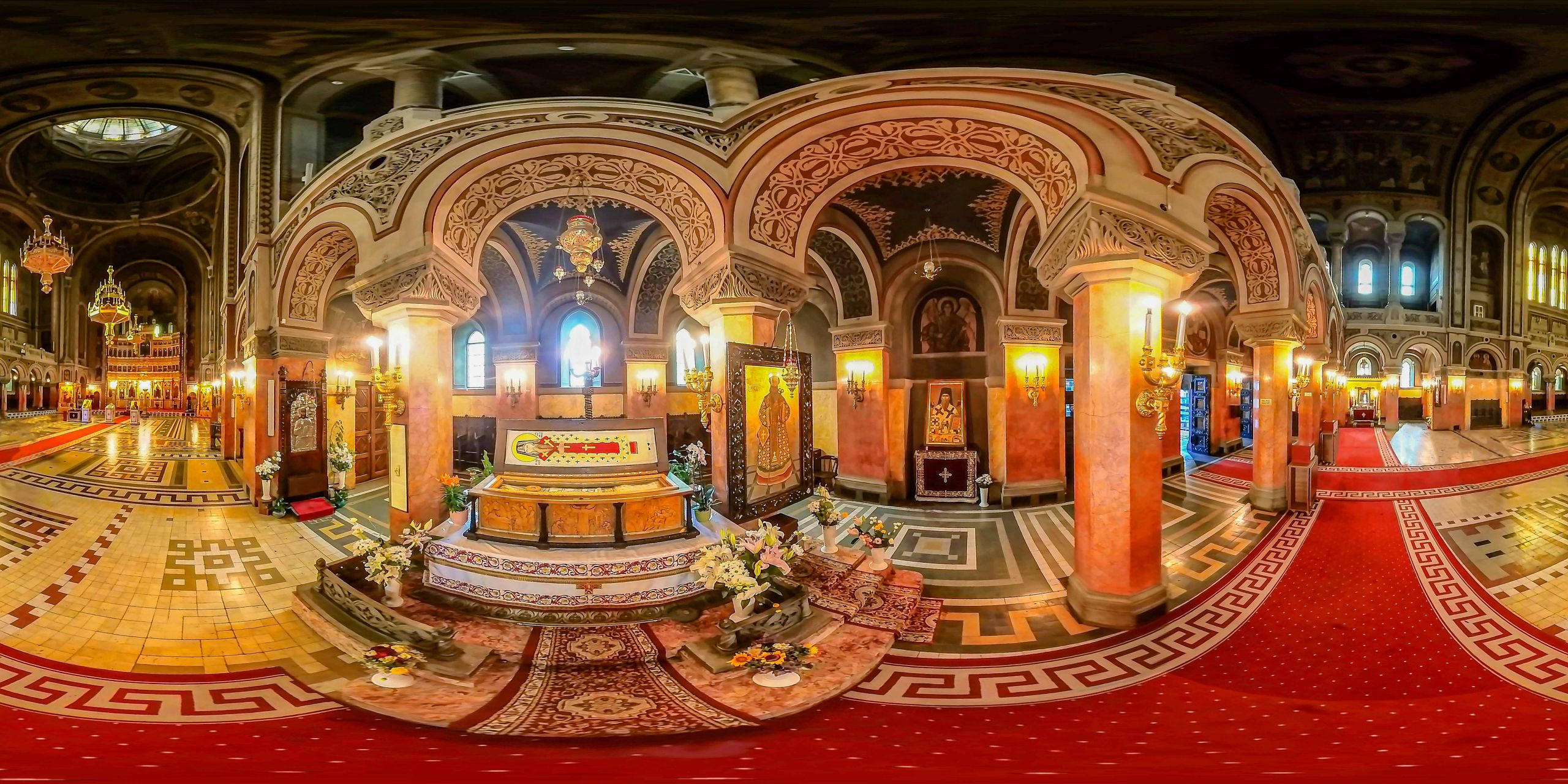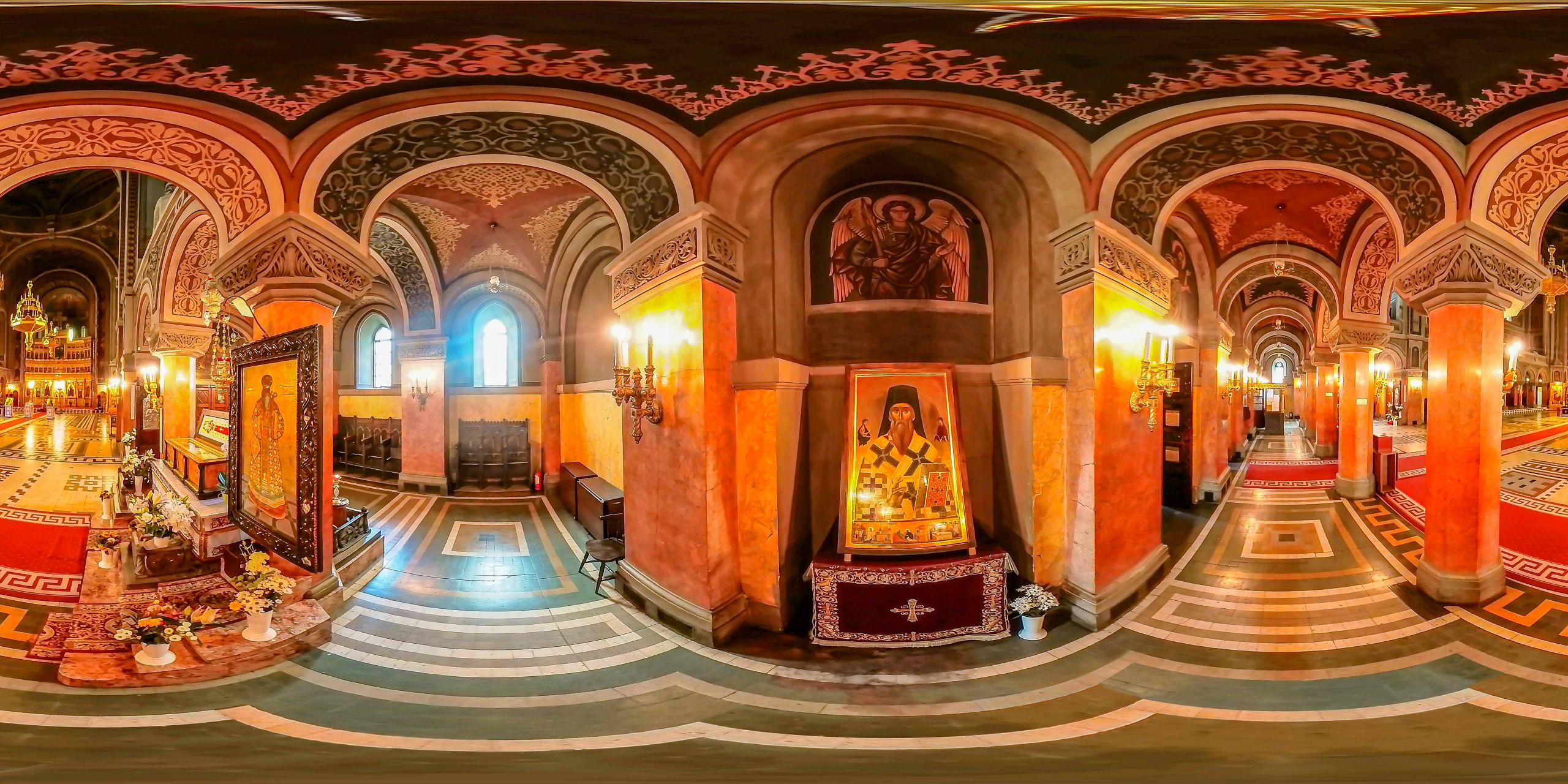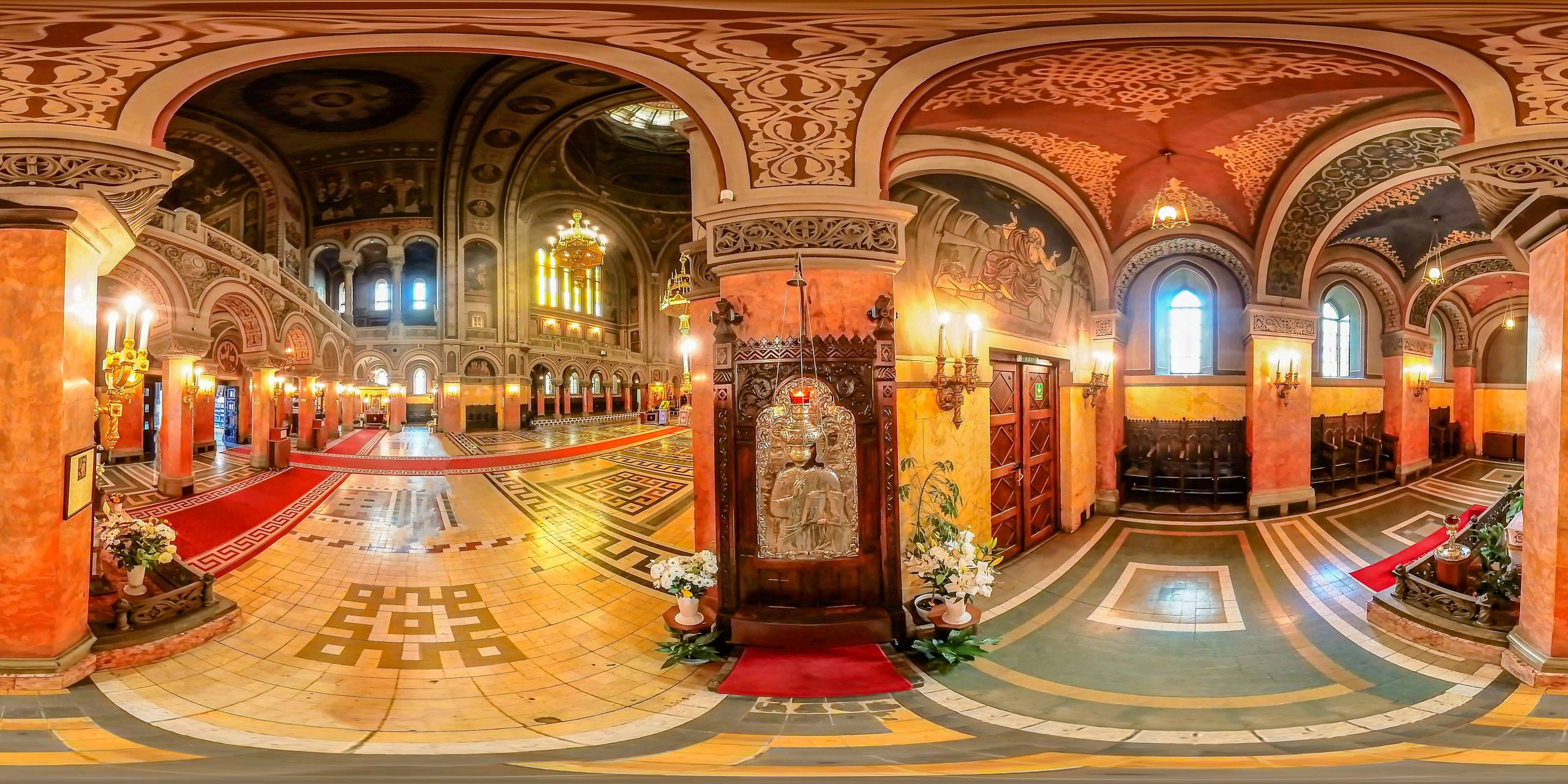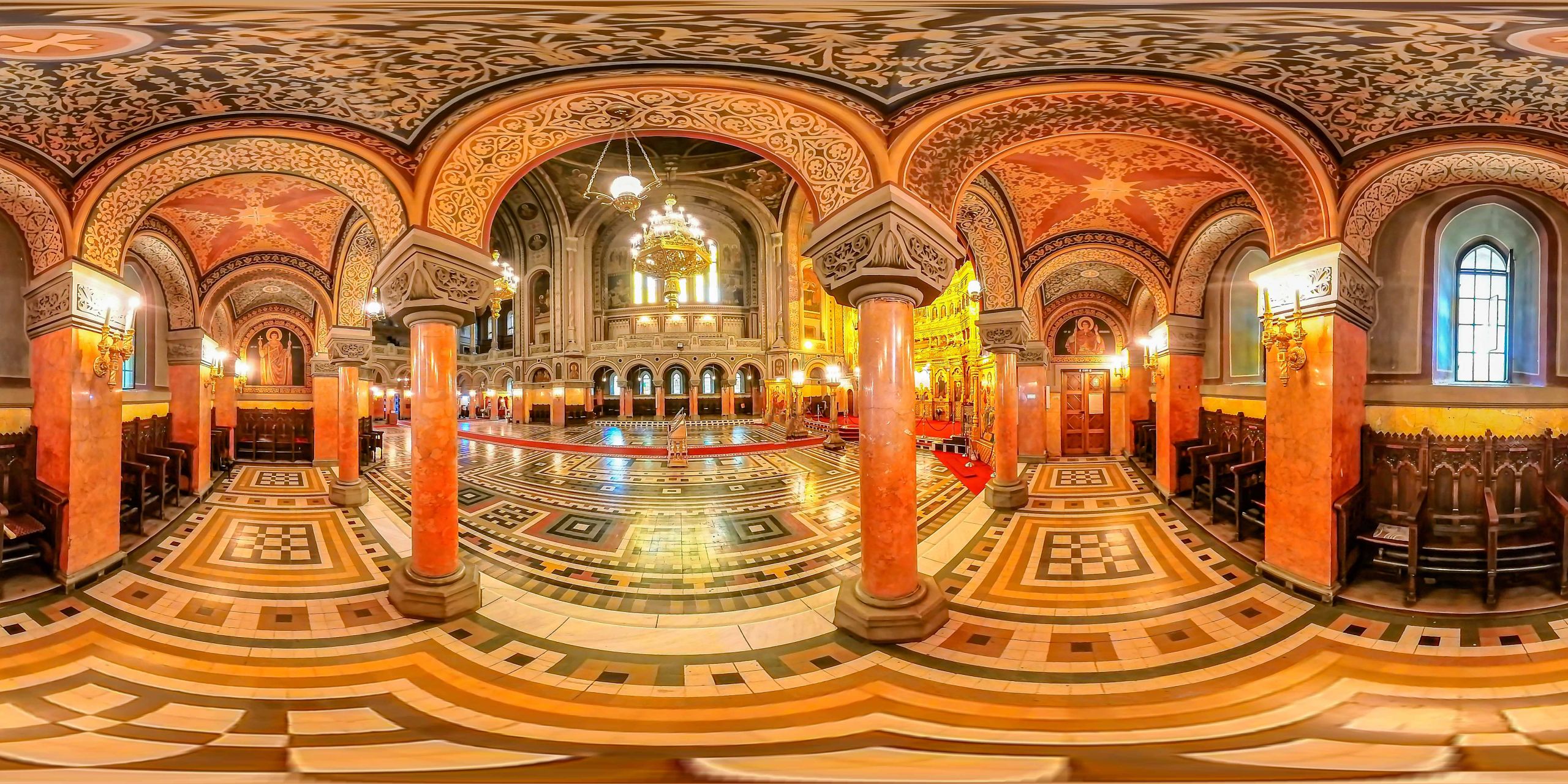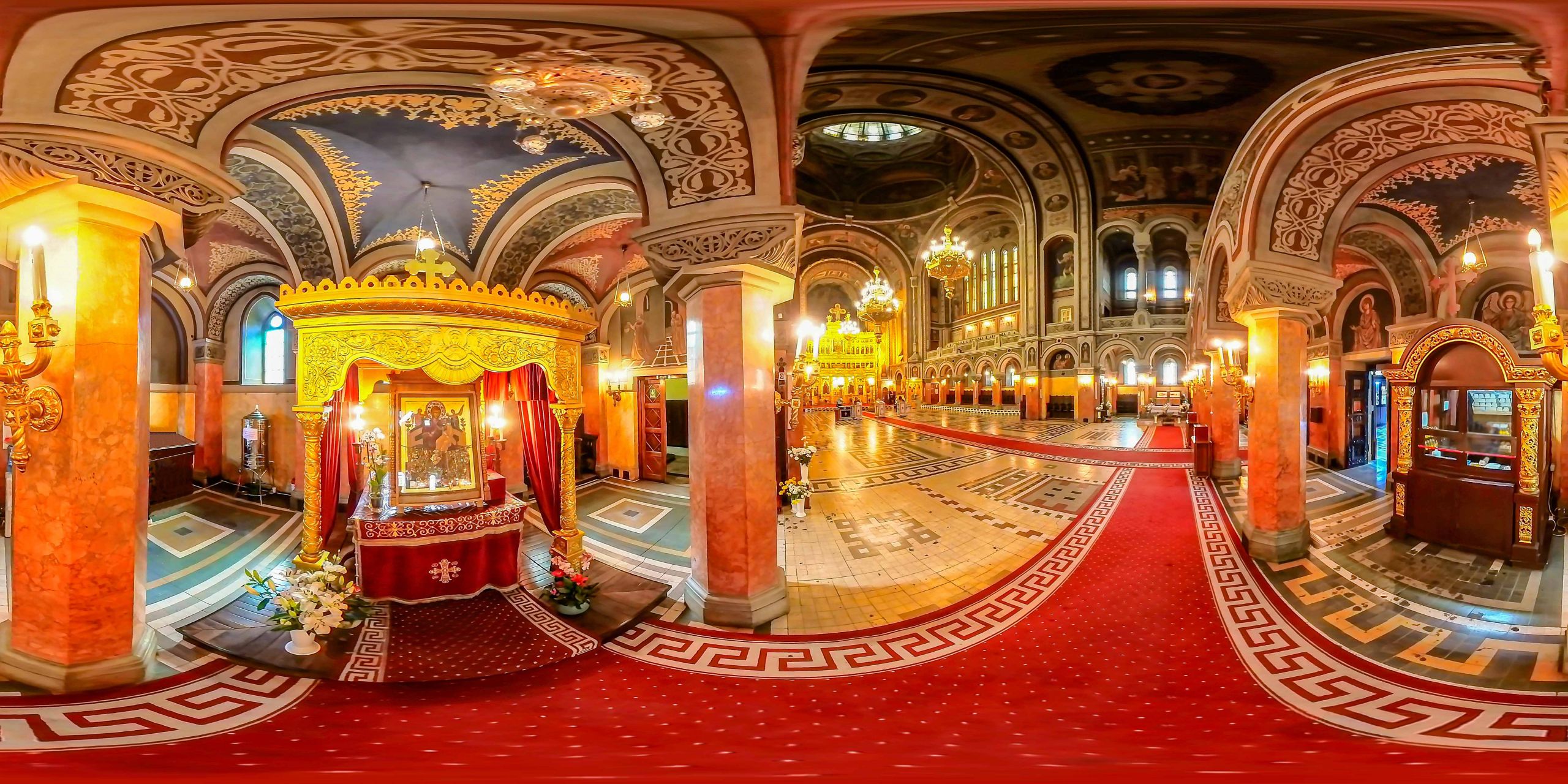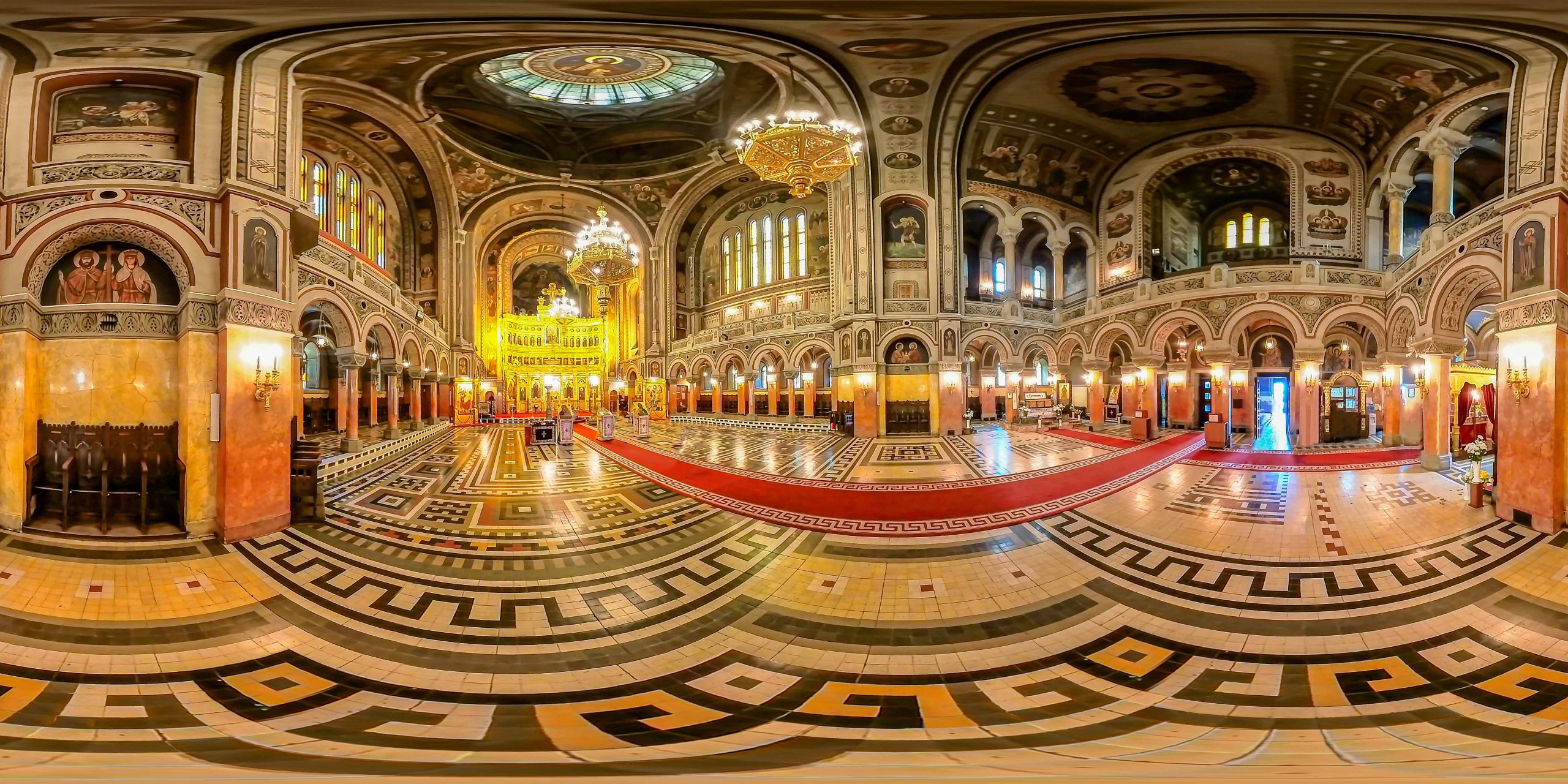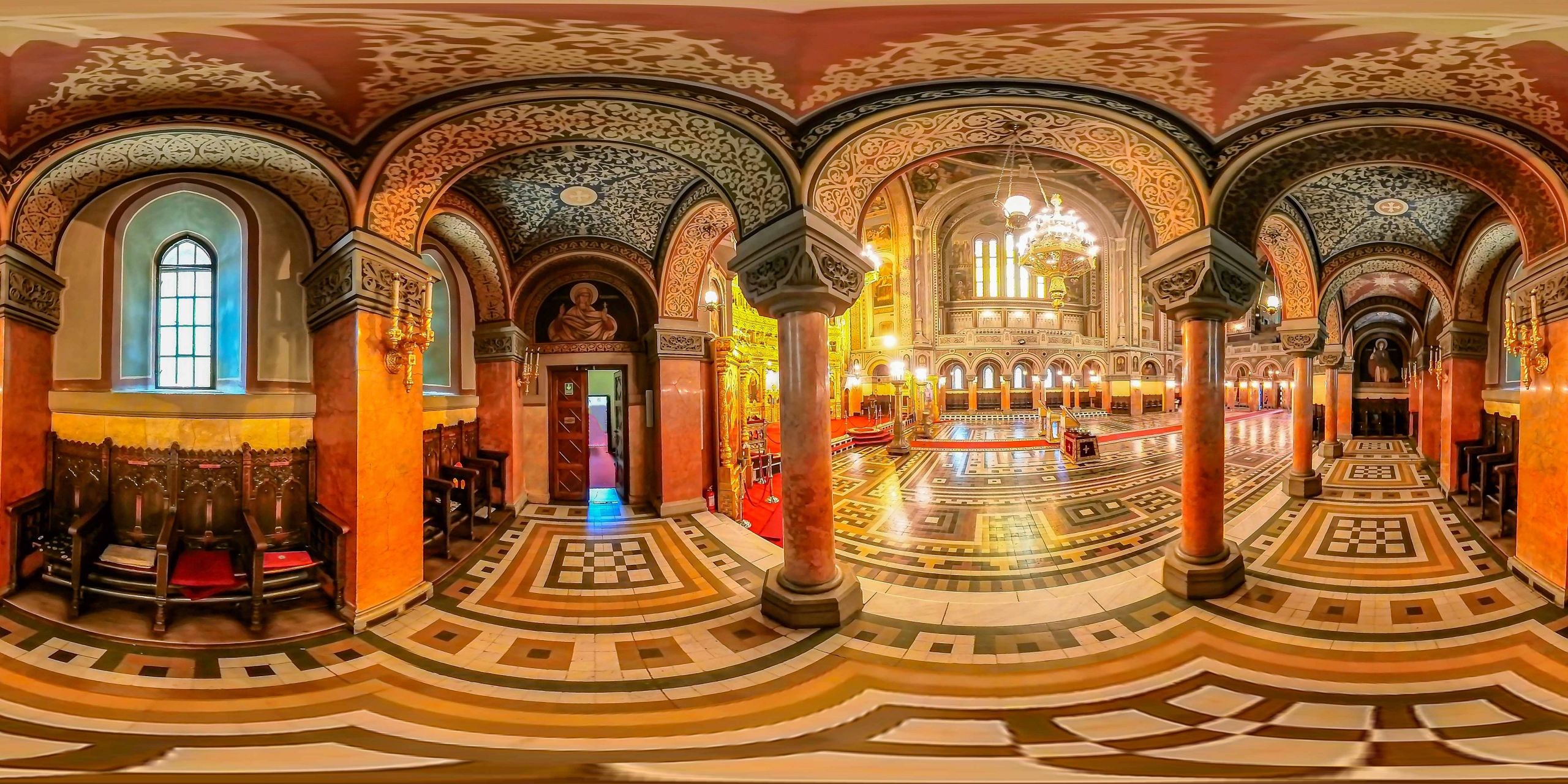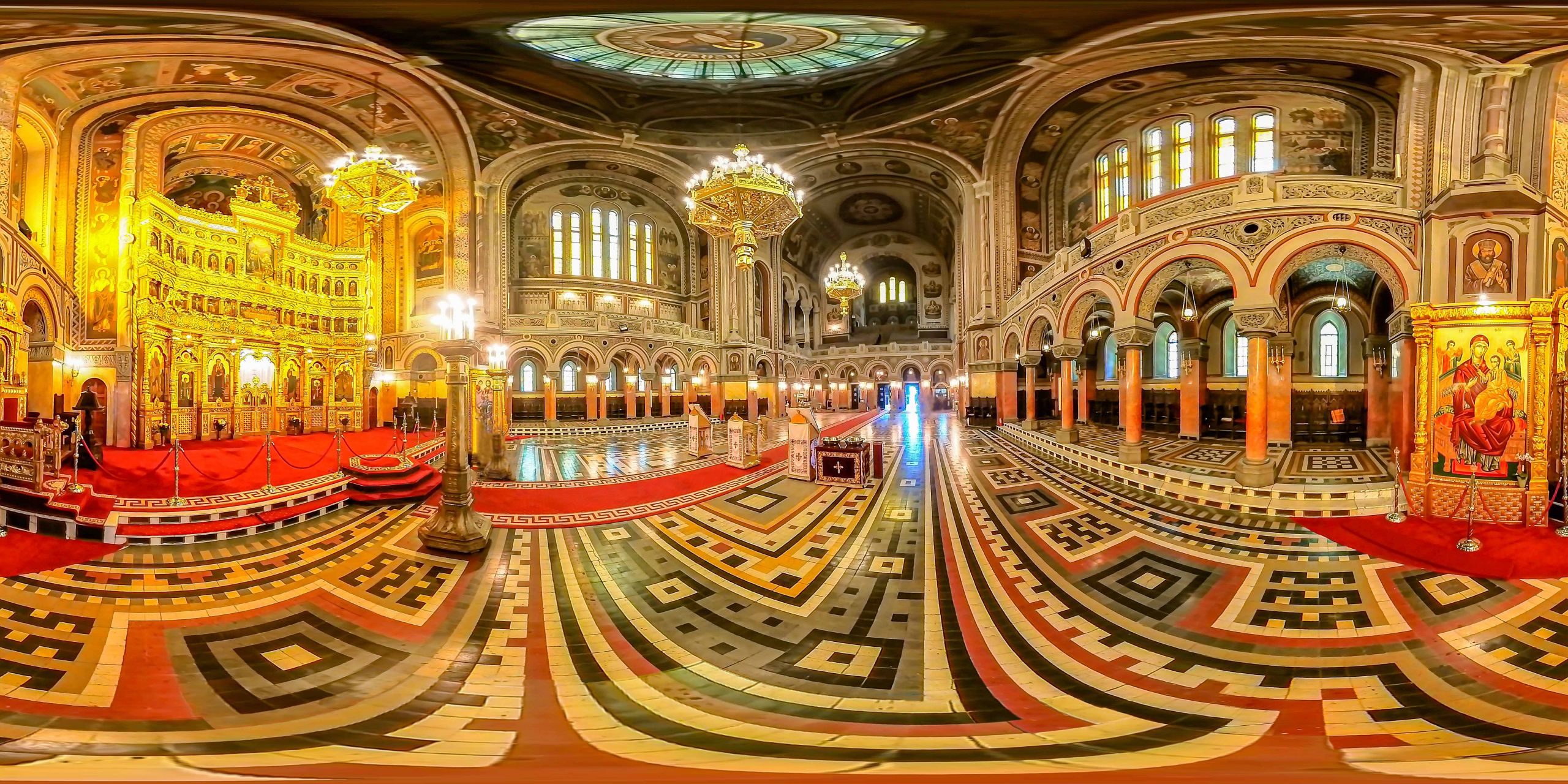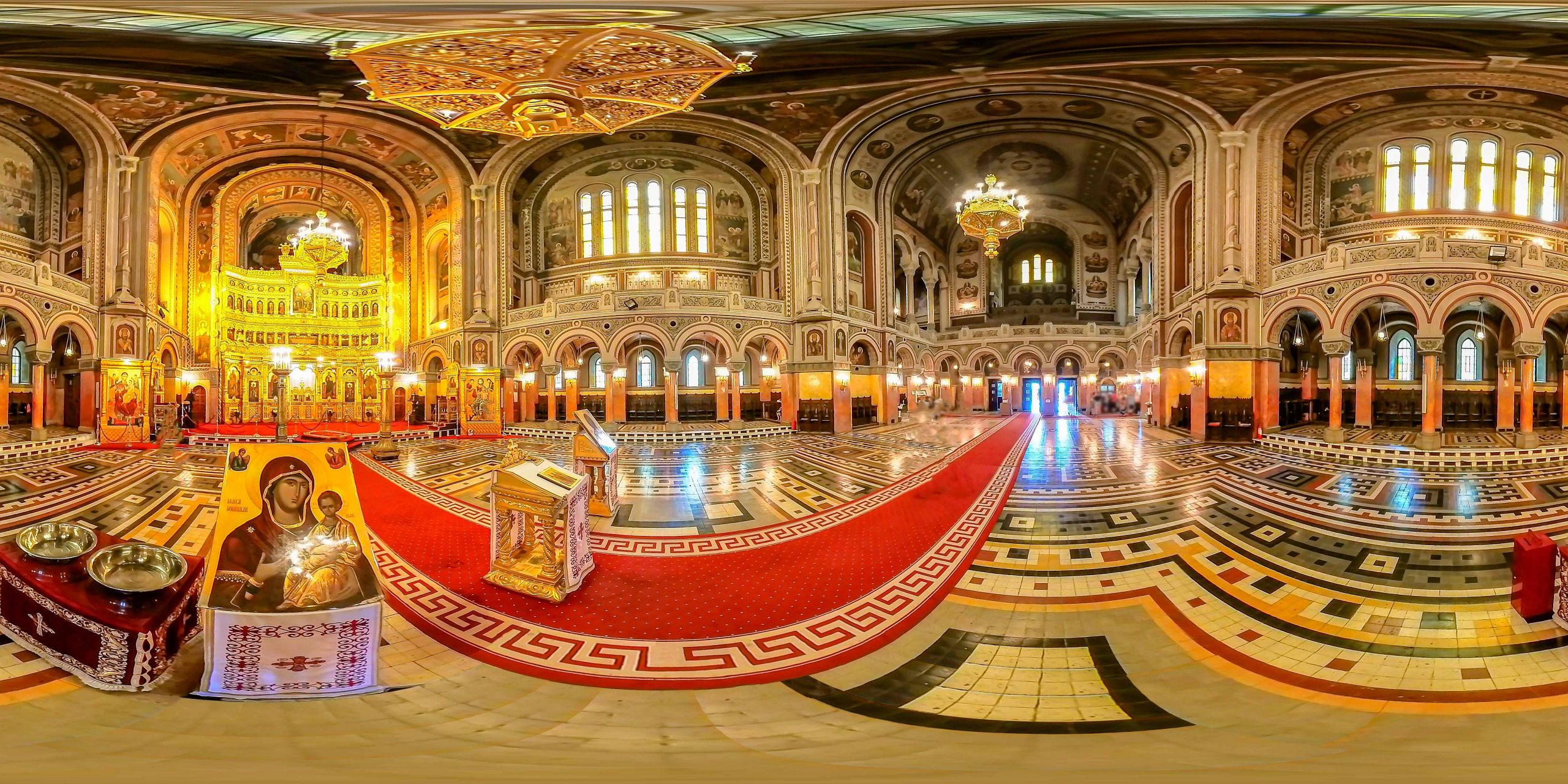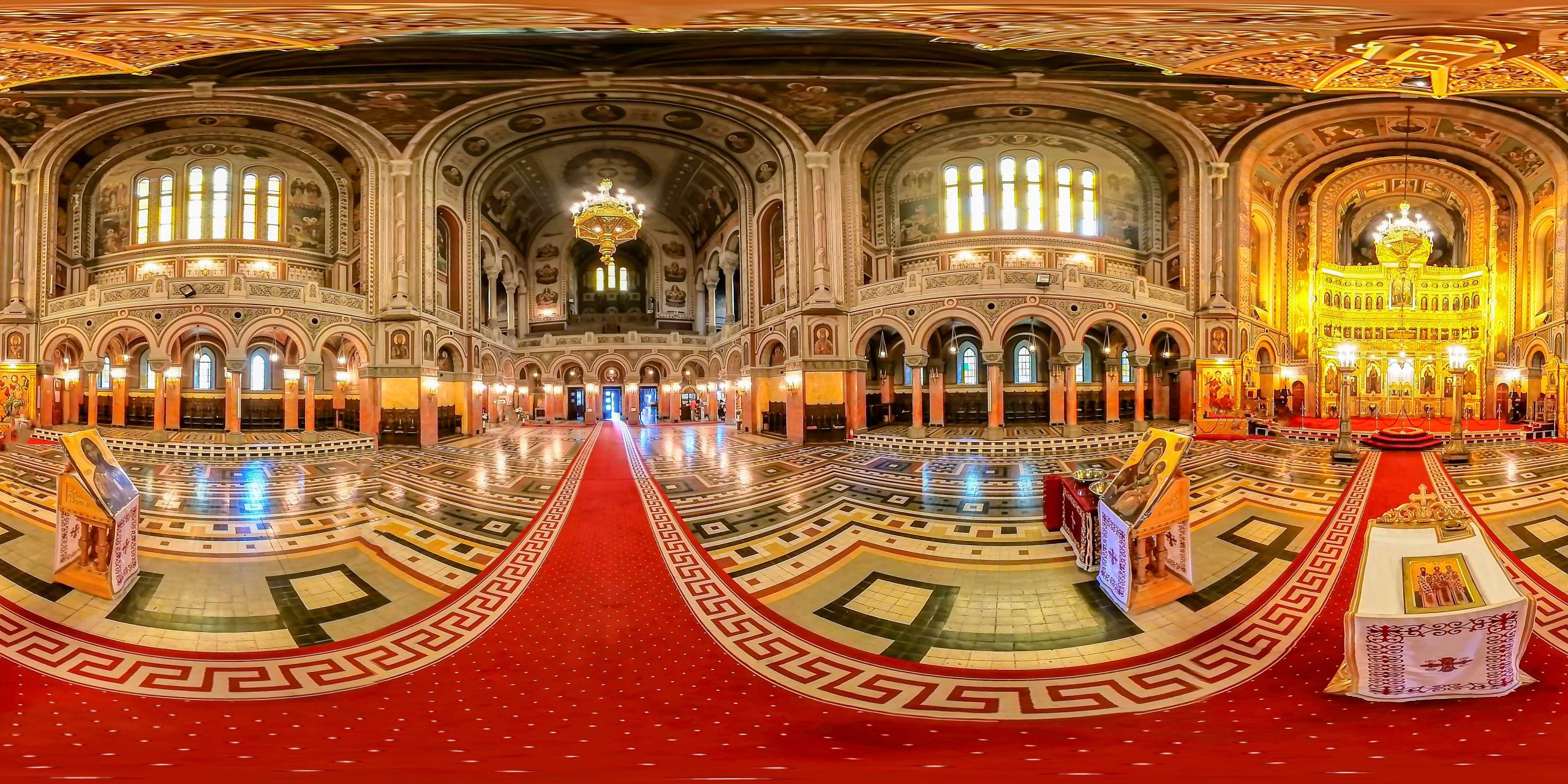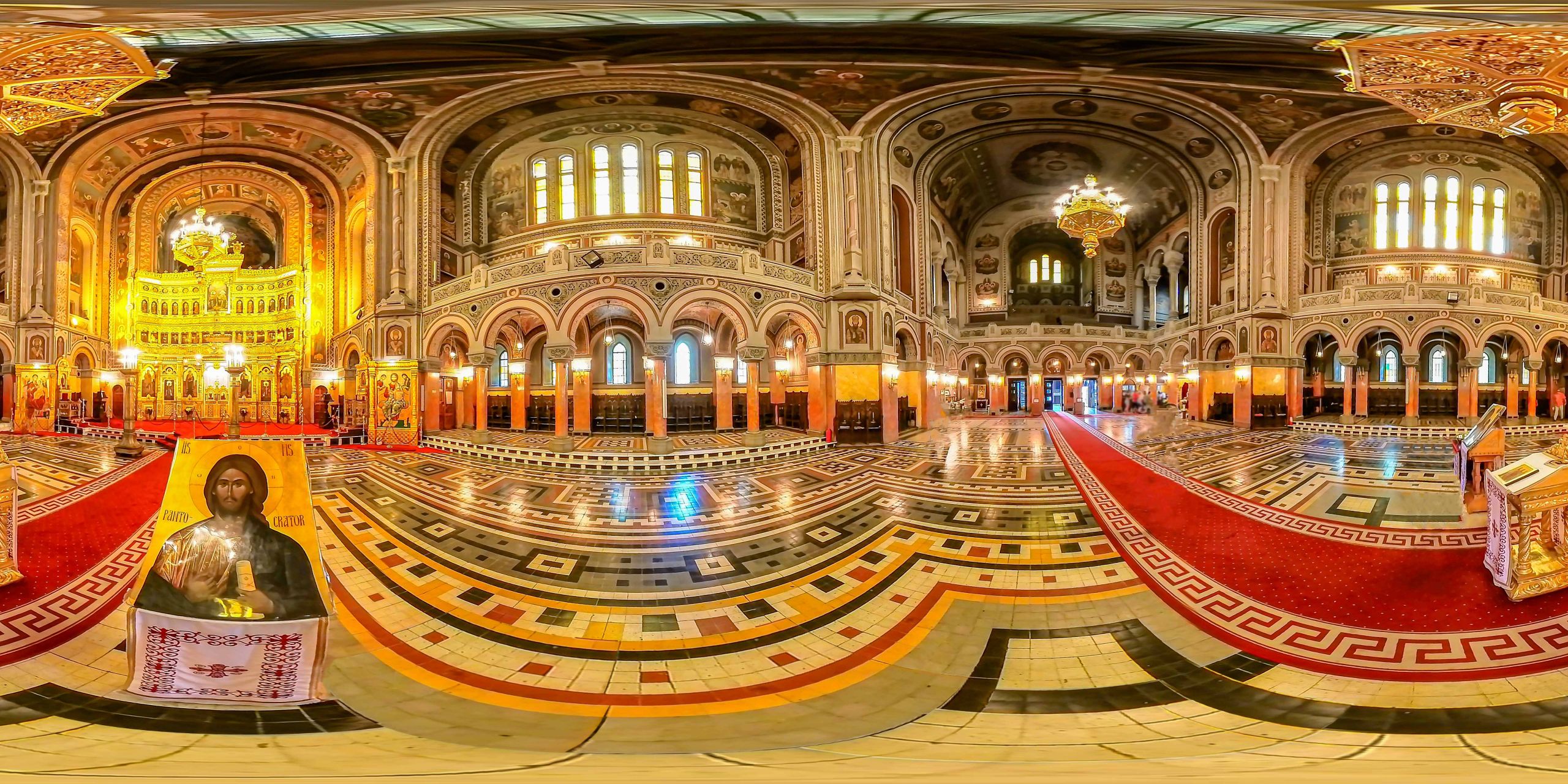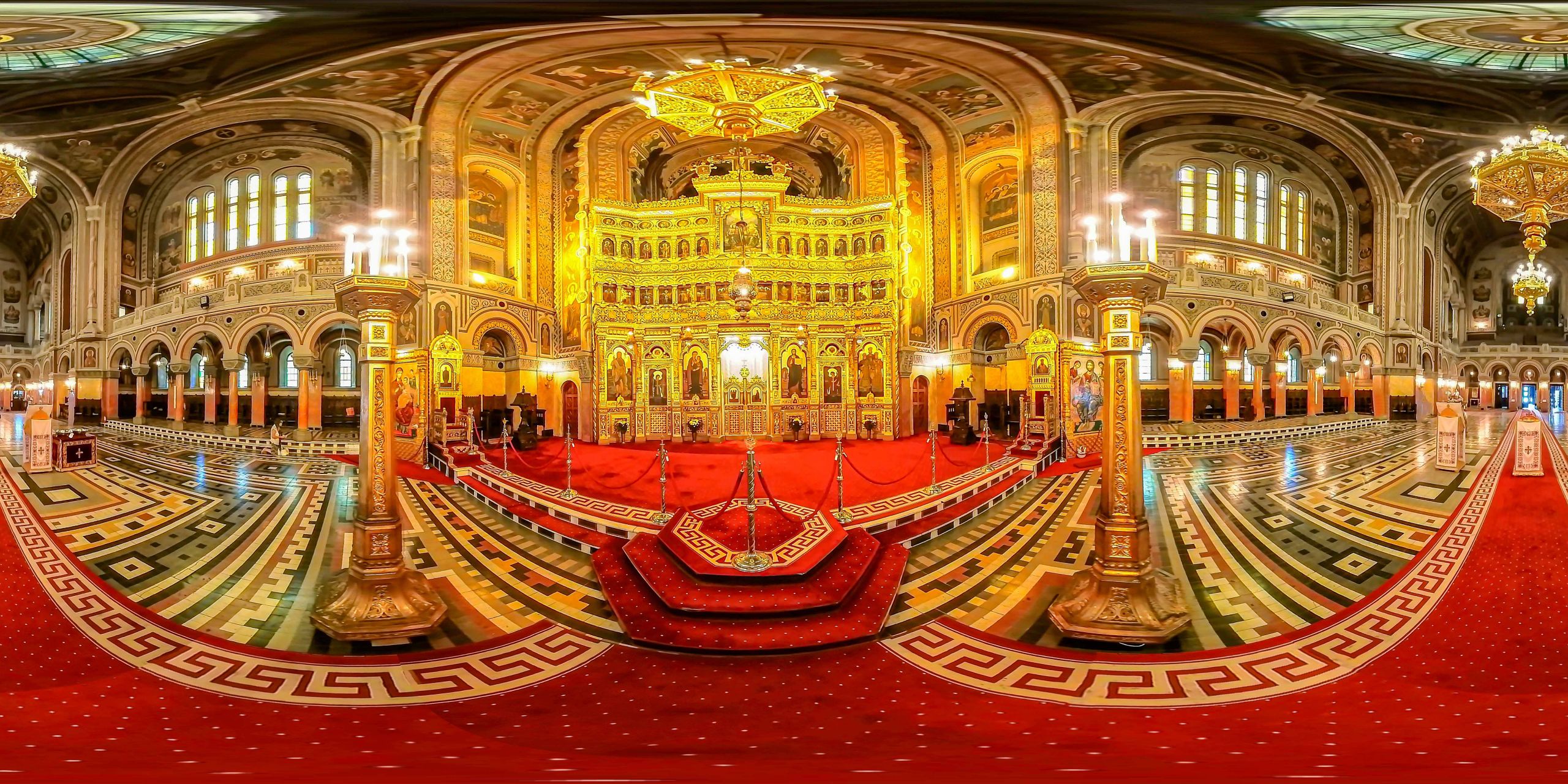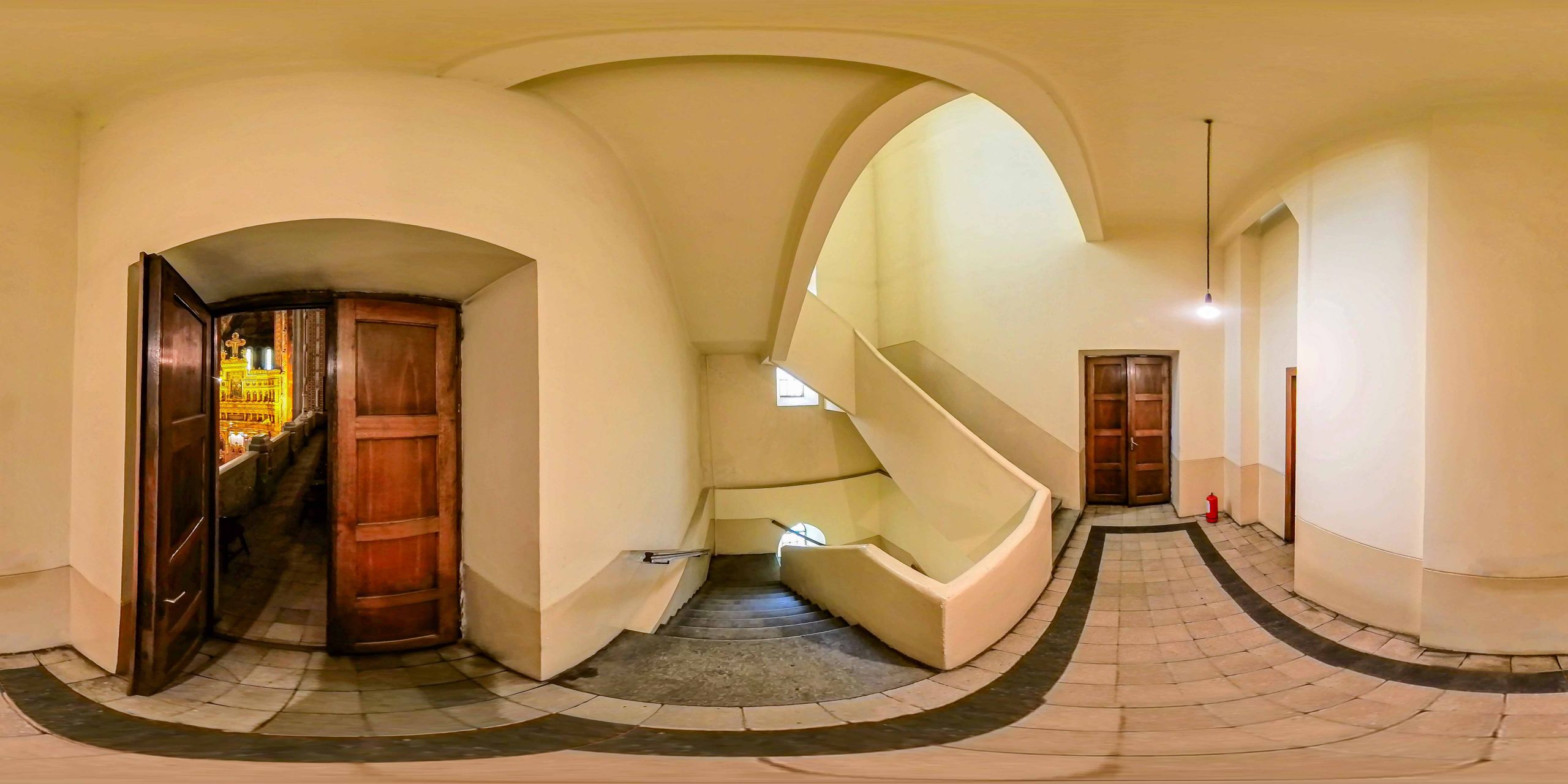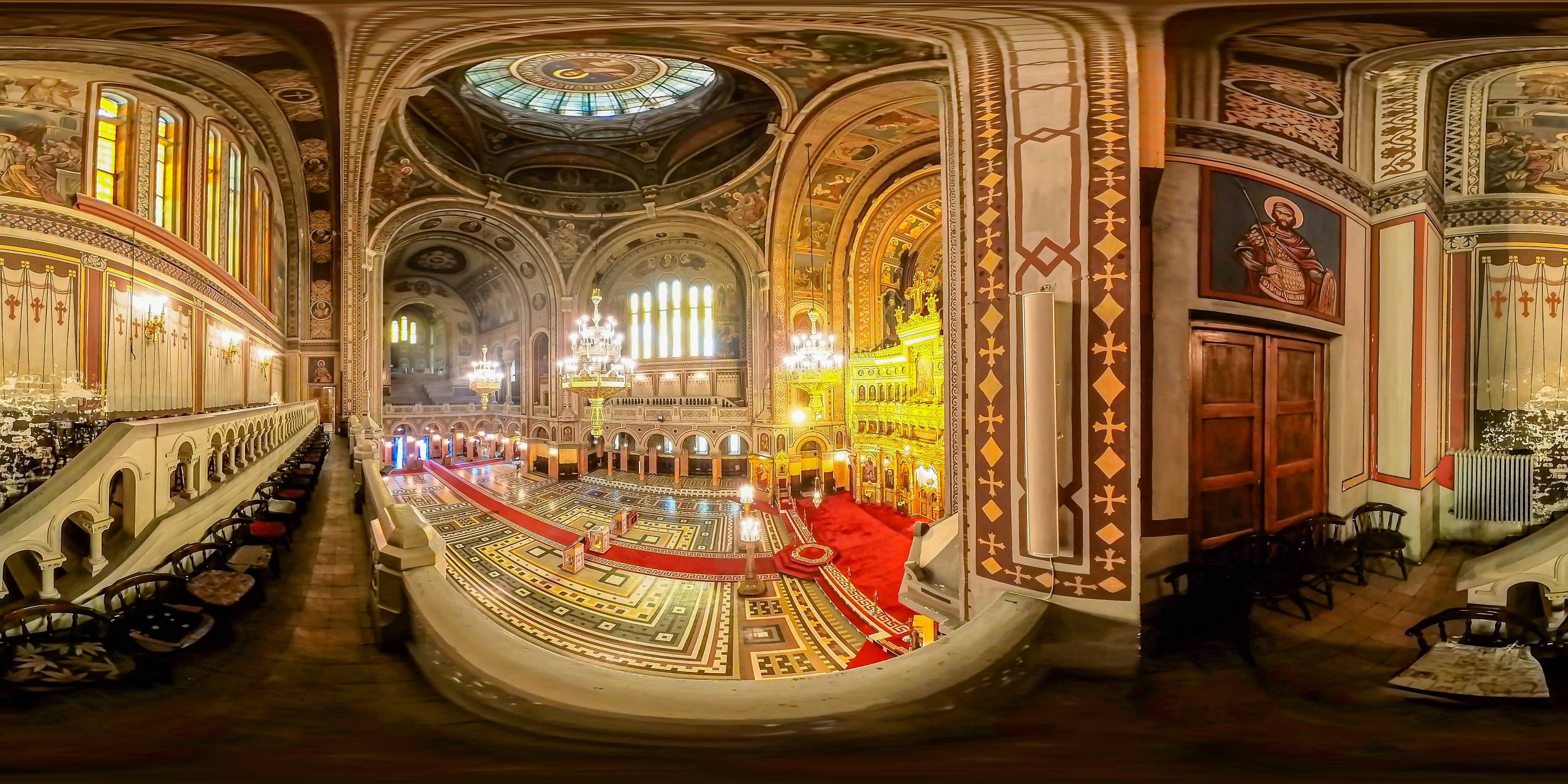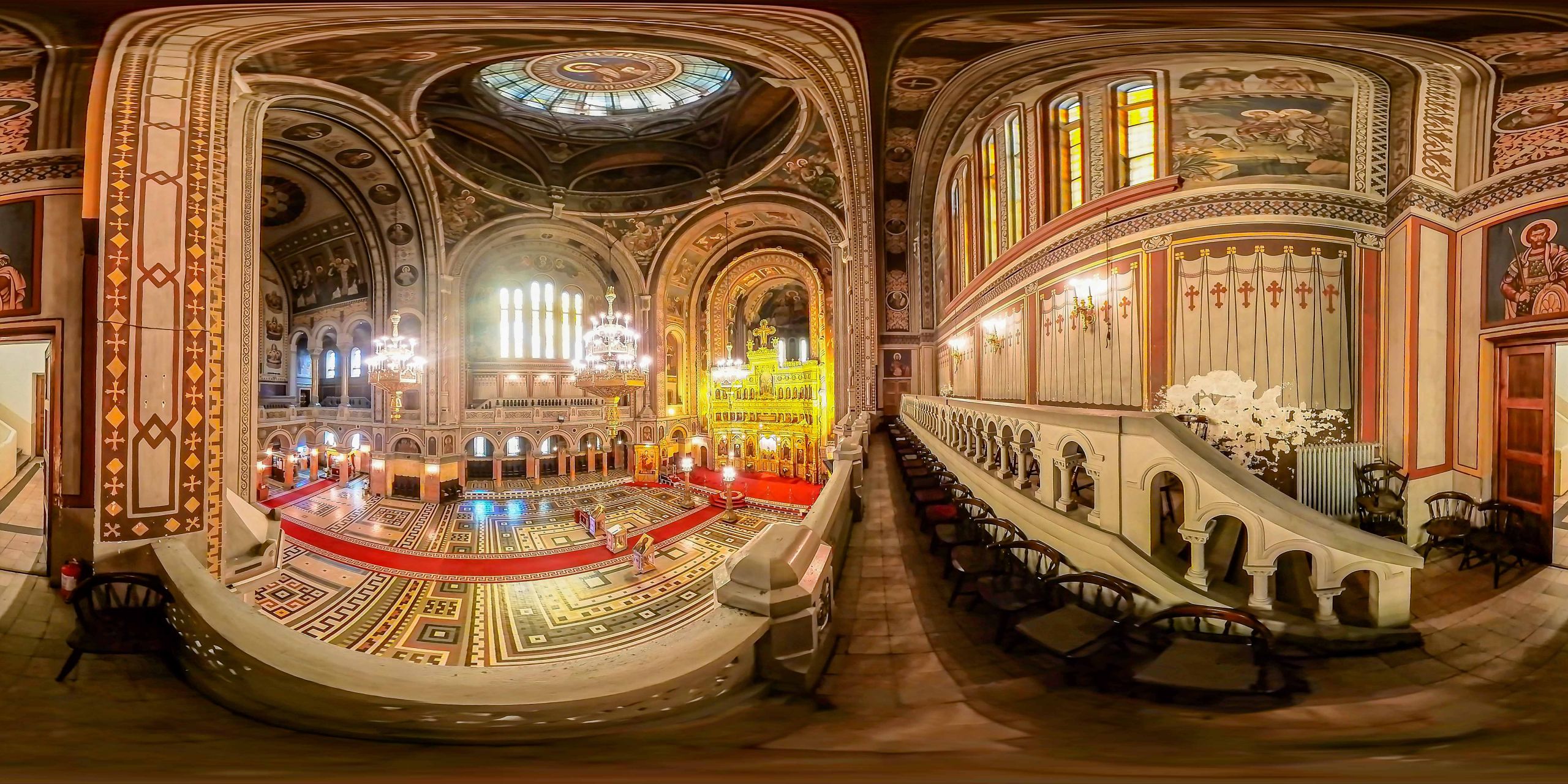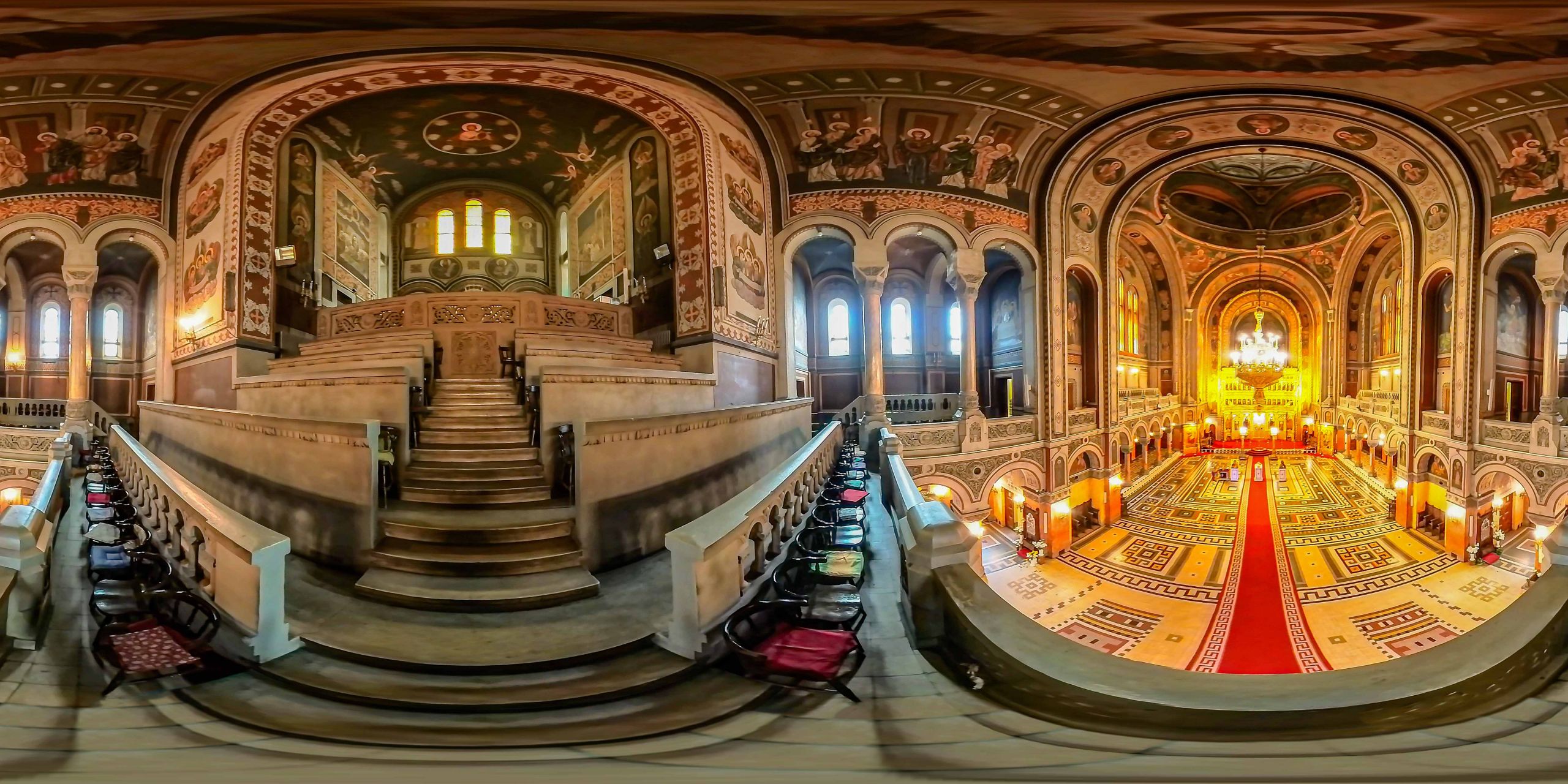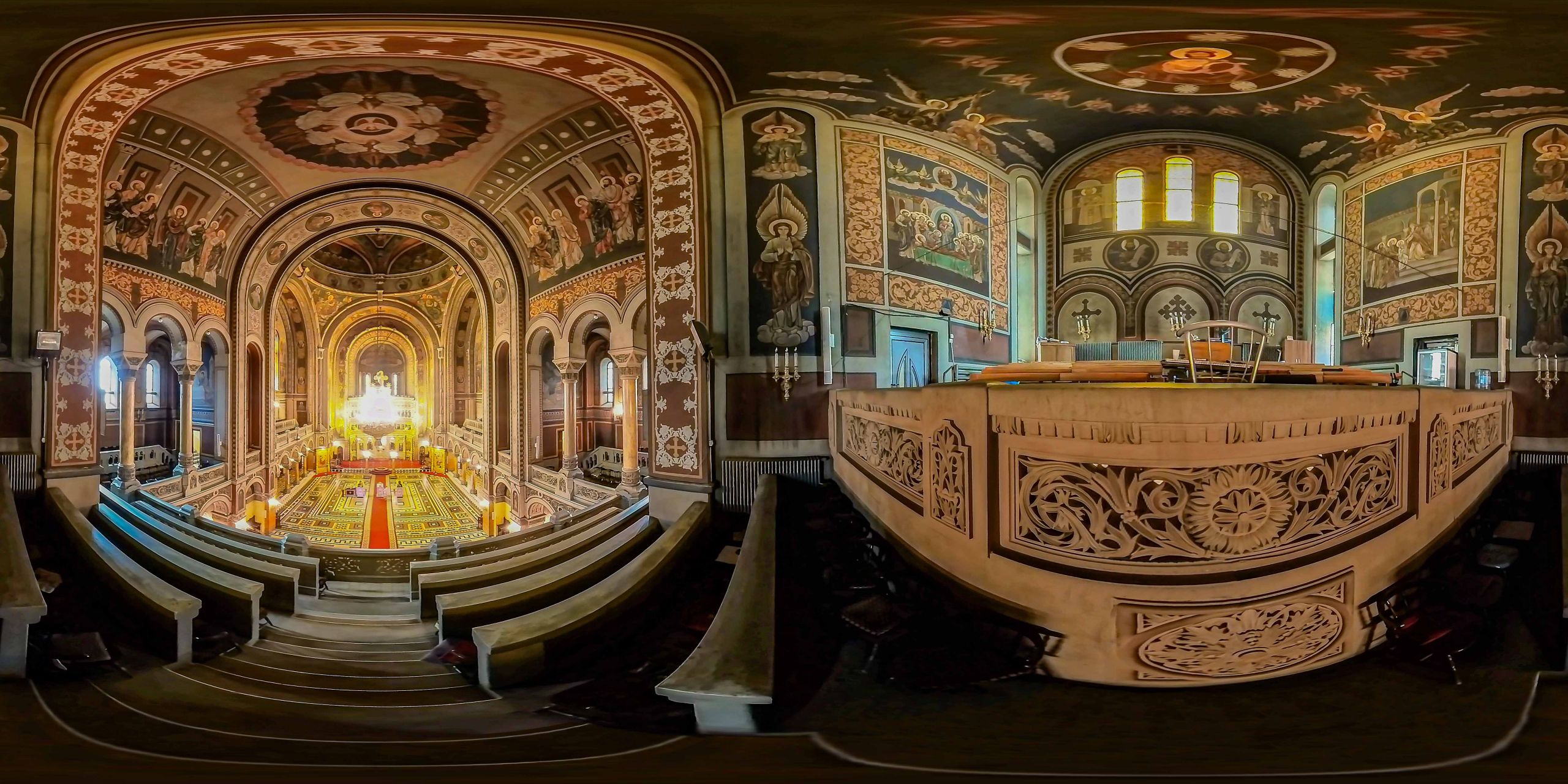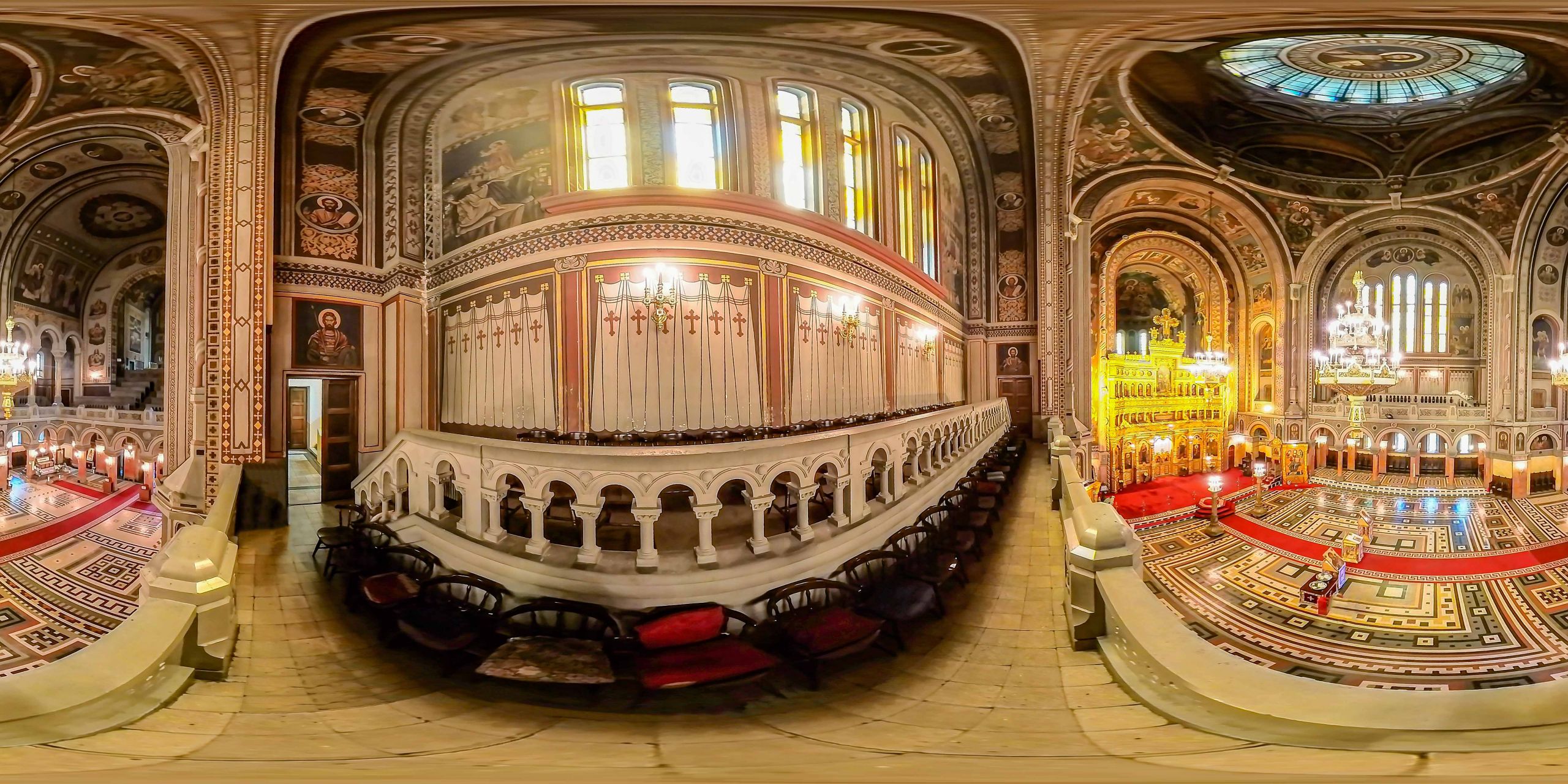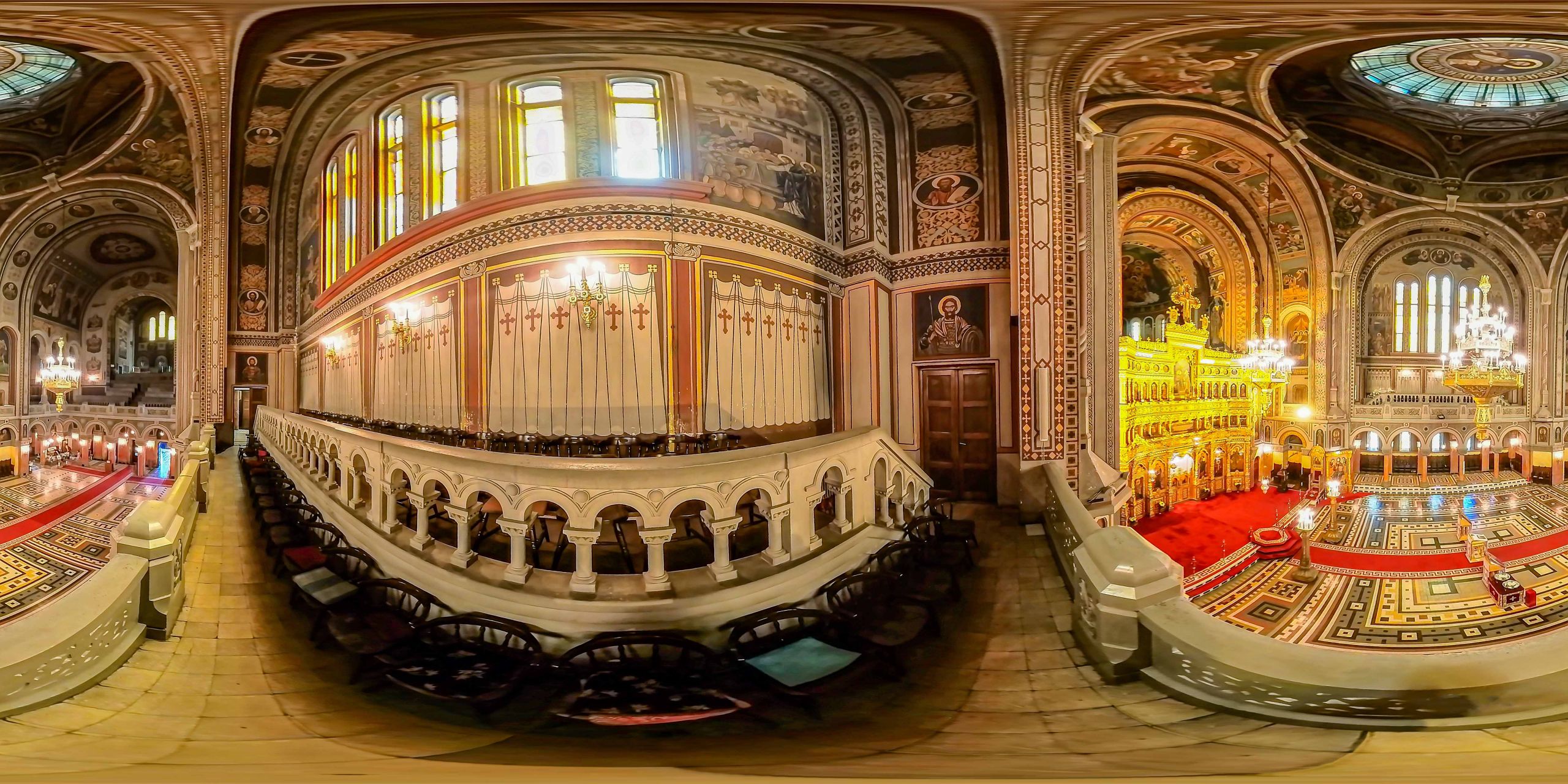The Orthodox Metropolitan Cathedral impresses both by its size and by the artistic value of the monument, being at the moment one of the most representative places of worship in our country. Built according to the plans of the architect Ioan Traianescu, the cathedral harmoniously combines the elements of Byzantine architecture with those of the old Romanian architecture. It was consecrated on October 6, 1946.
Listen to the audio version.
The Orthodox Metropolitan Cathedral impresses both by its dimensions and by the artistic value of the monument, being at the moment one of the most representative places of worship in our country.
The actual construction of the building began in 1936, with the consecration of the cornerstone by the Bishop of Arad, Andrei Magieru. Built according to the plans of the architect Ioan Traianescu and entrepreneur Tiberiu Eremia, paintings by Atanasie Demian, iconostasis and sculptures by Ştefan Gajo, furniture by Traian Novac; the cathedral is built in neo-Romanian / neo-Moldovan style, with Byzantine and eclectic elements inside. Broadly speaking, the cathedral was built over a period of five years, the built area comprising 1,542 m, the capacity of the Cathedral being estimated at about 5,000 believers.
On October 6, 1946, the cathedral was consecrated, and the procession was attended by, among others, Patriarch Nicodim Munteanu and King Mihai I.
The Metropolitan Cathedral dedicated to the Holy Three Hierarchs has a cross-shaped plan, the height of the dome reaching 83 meters. The foundation of the building is built on a huge reinforced concrete slab, supported by pillars driven up to 20 meters deep under the concrete slab. The towers are covered with glazed tiles, and the bells were harmonized by the composer Sabin Drăgoi.
In the basement, the Metropolitan Cathedral houses an impressive collection of old Banat church art and a valuable collection of icons. Also in the basement, we can find the necropolis of the metropolitans of Banat. The first metropolitan buried here was Vasile Lăzărescu. Inside, the cathedral was enriched with the relics of Metropolitan Iosif cel Nou, who were displaced from the Partoş monastery in 1956.
Bibliography:
- Ioan Munteanu, Rodica Munteanu, Timiș Monografie, Marineasa Publishing House, Timișoara, 1998, p. 319.
- I.D. Suciu, D. Niculescu, V.Gh. Țigu, The Cathedral of the Banat Metropolitanate, Banat Metropolitanate Publishing House, Timișoara, 1979.
- https://mitropolia-banatului.ro/prezentare-2/ - site accessed in May 2022.
- Mihai Opriș, Mihai Botescu - Historical Architecture in Timișoara, Tempus Publishing House, Timișoara, 2014
Romanian Orthodox Metropolitan Cathedral - Metropolitan Cathedral "Holy Three Hierarchs" in Timisoara
Listen to the audio version.
“In the alleys from the cathedral I found the soul of the classic. The same sadness, the same organic joy of stepping on Timișoara soil. For as long as I can remember, nostalgia; places and states without return, the north - maybe it doesn’t even exist as I imagine it and maybe I will never see it -, the face of a woman who was young twenty years ago, in another country. In all these, as in my great sad joys; books, trees, friends, hills and sunsets, and as in this city which I can read like a poem, in all these rests my soul.” (Livius Ciocârlie, The Sunken Bell, Cartea Românească, 1988, p. 323-324)
“We were literally carried away by the waves of people on both sidewalks, flowing like fast, colorful rivers, flowing, flowing tirelessly, in one direction: the heart and core of the great city. It seemed like the whole city was out in the streets...
We could see from afar the cross on top of the Metropolitan Cathedral and its colorful roof tiles glowing in the growing daylight. As we approached the city center, a distinctly human roar was growing louder. The high, white, clear sky proved that, though it was past mid-December, it would be a clear, sunny, spring-like day.” (Ion Arieșanu, The Best Die First, Timișoara, Amarcord, 1998, p. 87-88)
Find
by Tania Chitarici, 6th grade
"Grigore Moisil" Theoretical High School Timișoara
The clear sky was preparing to welcome the sunset. A surprising brightness makes me see the actual beauty of my city. The thought takes me back years ago, when it seemed grayer. It was because of the people, who didn't understand that beauty should be created and respected.
But the years have passed, people got involved, each in their own way, and now the city has taken on color and charm. Under the bright sunshine, the multiple colors of tulips create a real fairytale. Two curtains of mauve and yellow line the city center. On one side Metropolitan Cathedral, a representative and impressive place of Timișoara, and on the other side, the National Theater and the Opera, where culture makes people's souls more beautiful. Between the two landmarks, a fountain pours water, the source of our life. The joy of these beauties is enhanced by the presence of children, who are friends of the pigeons, in perfect communion with nature.
I can't forget the Children's Park, the place where I made my first friends, even today as I tell you about it. It seemed different. The trampoline area, my childhood favorite, was nowhere to be found. I remembered even years later its position in the park. Only then did I realize how much my childhood place had actually changed. In place of the trampolines, a stone wall had been erected with several works of art, which belonged to a children's handicraft workshop. It was also specially designed for children. My happiness combined with nostalgia for the Children's Park. Of course there were more changes, but this one was more special, with more delicate memories.
After leaving the park, I felt the power of a breeze, bringing back almost lost memories. It made me think of how many fascinating things I had missed because of my departure for college. I had been given a chance in a very good place in Bucharest, that I couldn't afford to refuse that invitation, which fulfilled my dreams.
I had realized that Timisoara was my home, and now it is no longer necessary to part with it.
Saying these things in my mind, I had seen a sight that made me come to terms with the decisions I had made, knowing that some things can remain unchanged. The Bega canal, for example, delighted my eyes. I remember the first trip on it with my parents, on a boat, with symphonic music. I didn't like it, but my parents were smiling, which calmed me down and gave me the same wave of positive energy that they felt.
Seeing a boat similar to the one in the past, I realized that I still had enough free time to take another lap on the water, which would surely give me new sensations already had from the first ride. I felt a breeze caressing my hair.
The walk was over, but I continued to explore my memories, as if brought to life again. I had visited all the places that were dear to me. It was time to return to my parents. The streets seemed more crowded than usual, but concentration seemed to have taken hold of people's faces. Everyone was in a hurry. I realized that people around me were hurrying to get to their homes because of the clouds that had appeared above us. But I was enjoying every moment with the city where I was born, where I grew up and where I made unforgettable memories.
It was wonderful to feel, after so many years, a mixture of nostalgia and the freshness of the new generation of Timisoara's people.
Timisoara, a fairytale place
by Iulia Nicorescu, 6th grade
"Grigore Moisil" Theoretical High School Timișoara
It's a beautiful spring day. I, a skinny little spider named Max, am sitting, as usual, under the corner of Julia's desk. I used to live in the bell on the desk, but so noisy was the class that I shuddered every minute.
Suddenly, the big bell rings. Class is over. As Julia was getting ready to go home, I thought it would be a good idea to get into her backpack. But just then, the look on her face surprised me.
- Aaaaaaaaaaa! It's a spider! she screams. But... wait... it's so tiny!
- My name is Max, I tell him. And you're Julia. I got bored sitting in class, so I'd like to see this town. Can you show me around? I hear it's full of wonders.
Julia was surprised at first, but we became fast friends and soon we ended up together in the center of Timisoara. It's wonderful! So many smiling children and impressive buildings!
- This is the Opera, she said. This is where I danced for a ballet show. Isn't it gorgeous? Oh, and here are some shops, and there's the lovely Cathedral. Oh, how I love the sound of its bells! Come on, there are so many more markets to see!
I was exhausted. I'd already forgotten the names of the buildings. Now I'm in Union Square. I look at the big statue. How many spiders are there! That must be where they live. I asked Julia if we could go and she said yes.
- Hi, I'm Max! Nice to meet you. I'm here for the first time.
- Hello Maaax! they greeted in chorus. We're the Beardy Spiders. If you want, come with us and we'll show you everything!
I looked at Julia and told her I would stay here with the others.
-I take it we won't be seeing each other at school again, right? I'm sorry.
I felt like crying. Only now do I realize that nothing will ever be the same. Instead, I'll have the most precious thing: friends. Of course I'll miss her too, so I made her a promise.
-I promise I'll visit you on Monday under your bench. Bye, Juli!
I hugged her with my little hands and she smiled. Then she slowly, slowly pulled away. The Beady Spiders led me back to the Opera House. I entered, curious. I leaned over the edge of the balcony so I could see the show. It was about Timisoara, a special city. I inadvertently slipped off the balcony onto the stage. A girl saw me and screamed.
-I'm not hurting you! Actually, I'm here to find out about the city.
A gentleman picked me up and put me next to a big microphone and I started to speak. People looked at me puzzled.
- I'd like to talk about what Timisoara is like from a spider's point of view. First of all, I can spend hours looking at the millions of details on the buildings. It's all so big and fabulous. Their history is most fascinating. Did you know this Opera House has been through two fires? It's absolutely marvelous how you can walk through places steeped in history. Of course, reconstructed, but the same place. You must certainly do your city proud! It was also European Capital of Culture! Boast about Timisoara. It's a fairy-tale city. Magic, full of hidden histories. Who knows, maybe there's something hidden here somewhere. Thank you for your attention, darlings. Thank you. Thank you.
The audience applauded me emotionally. Someone even said they'd take me to talk to the mayor. A melancholy flooded my soul, remembering how small and insignificant I felt before I knew everything. But I soon recovered, seeing the cathedral through a window. Perhaps one day I will discover its secrets...
Until then, I will enjoy every moment in this fairytale place, Timisoara!!!
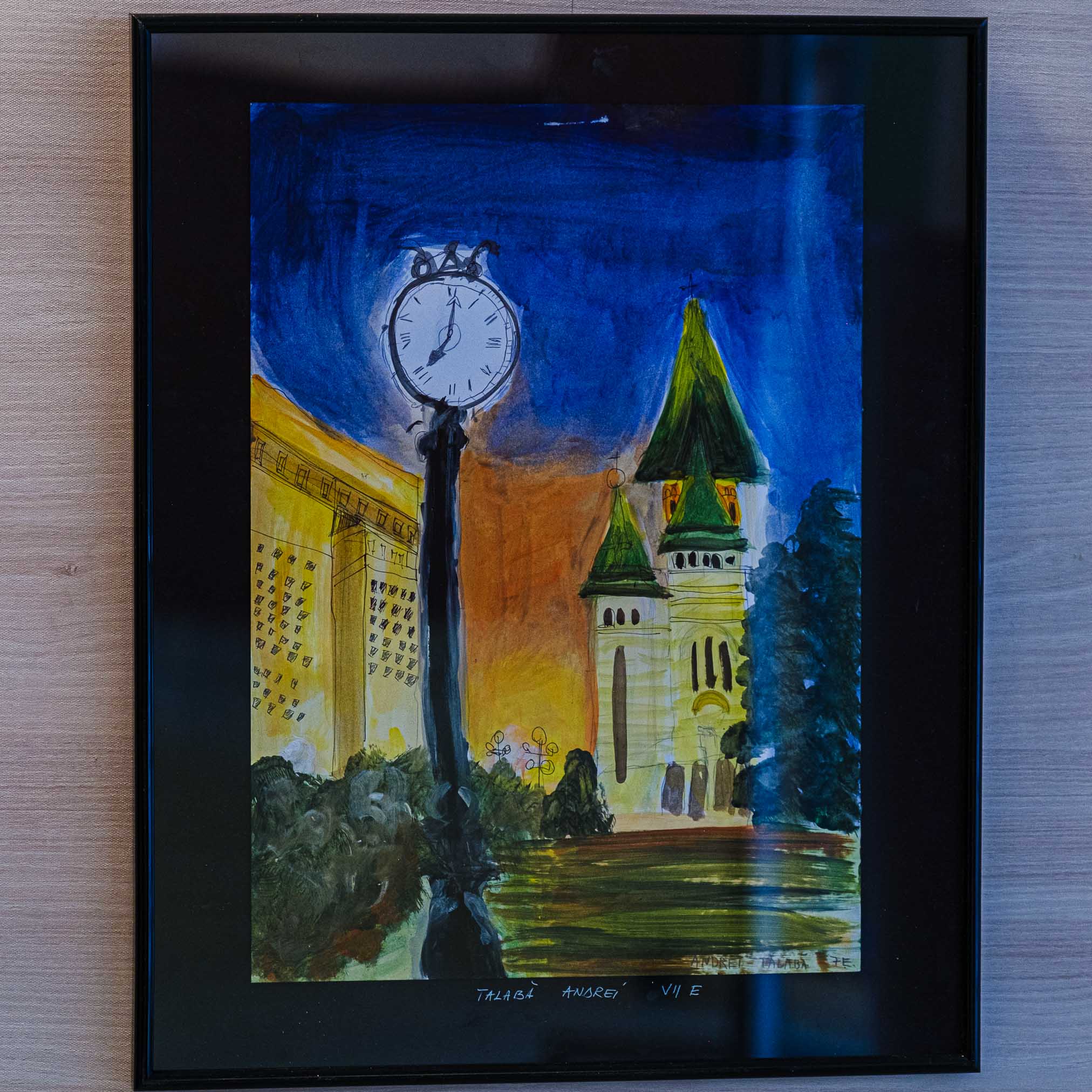
Artwork by Andrei Talabă, 7th grade E student General School no 19 "Avram Iancu" in Timișoara and exposed to UPT Library within the exhibition "Timisoara's Stories - A Visual Journey through Timisoara" - within the Creative Schools Project - Timisoara's Stories - a continuation of the Spotlight Heritage Timisoara project, part of the cultural program of the Timisoara Cultural Capital 2023 - project that brought together over 1600 children and teenagers and more than 60 teachers from Timisoara's schools, in over 50 interactive activities.
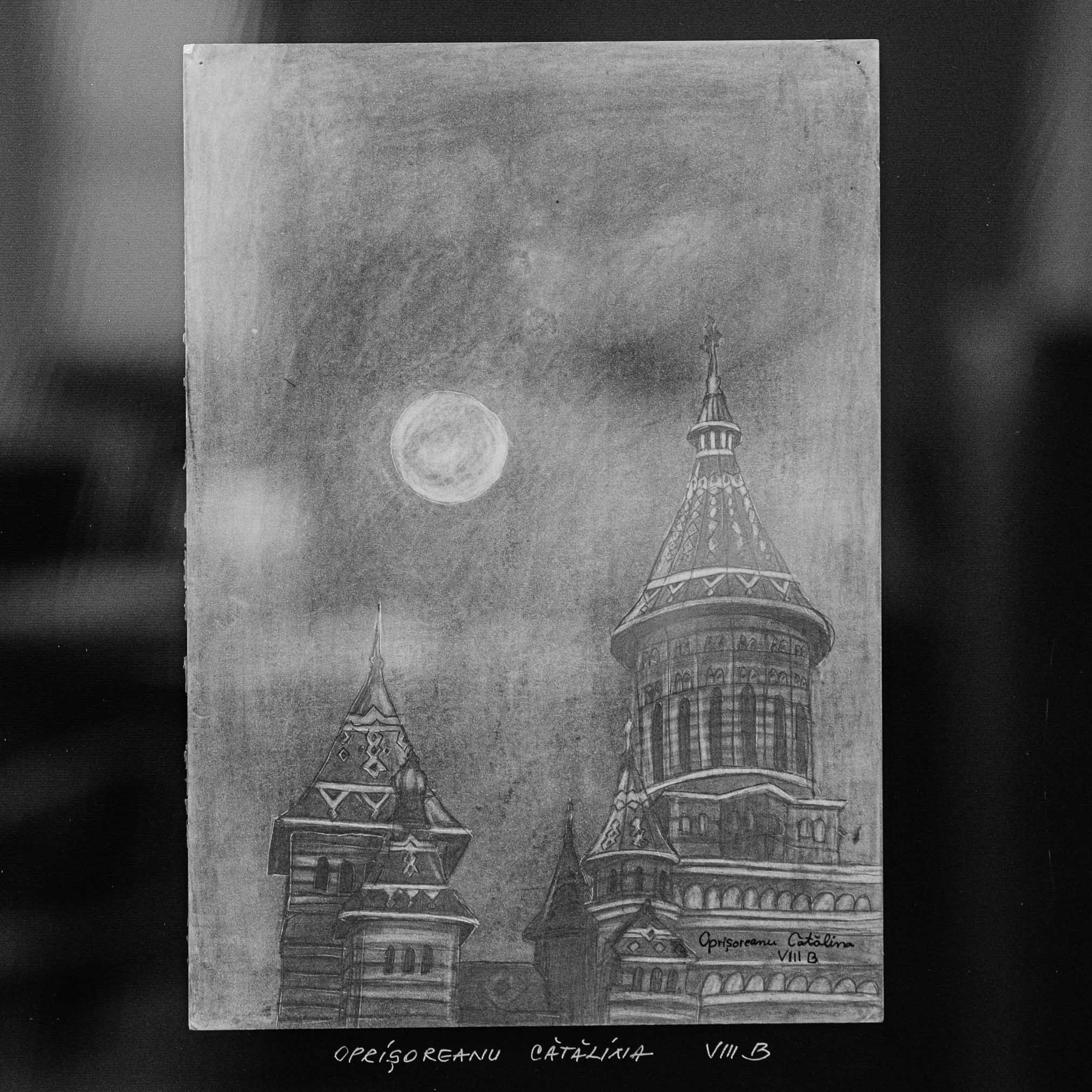
Artwork by Cătălina Oprișoreanu, 8th grade B student General School no 19 "Avram Iancu" in Timișoara and exposed to UPT Library within the exhibition "Timisoara's Stories - A Visual Journey through Timisoara" - within the Creative Schools Project - Timisoara's Stories - a continuation of the Spotlight Heritage Timisoara project, part of the cultural program of the Timisoara Cultural Capital 2023 - project that brought together over 1600 children and teenagers and more than 60 teachers from Timisoara's schools, in over 50 interactive activities.
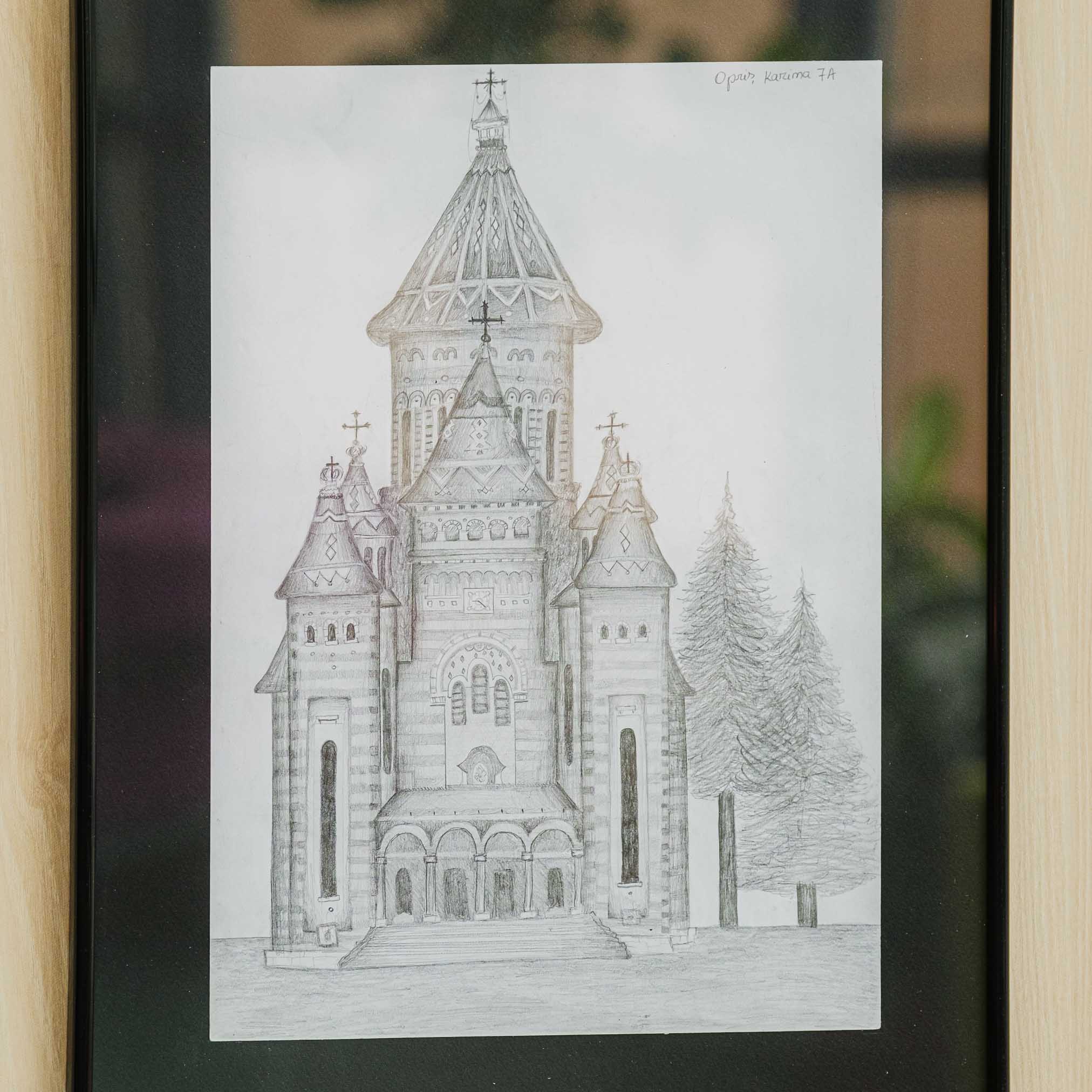
Artwork by Karina Opriș, student in 7th grade General School No 19 "Avram Iancu" and exposed to UPT Library within the exhibition "Timisoara's Stories - A Visual Journey through Timisoara" - within the Creative Schools Project - Timisoara's Stories - a continuation of the Spotlight Heritage Timisoara project, part of the cultural program of the Timisoara Cultural Capital 2023 - project that brought together over 1600 children and teenagers and more than 60 teachers from Timisoara's schools, in over 50 interactive activities.
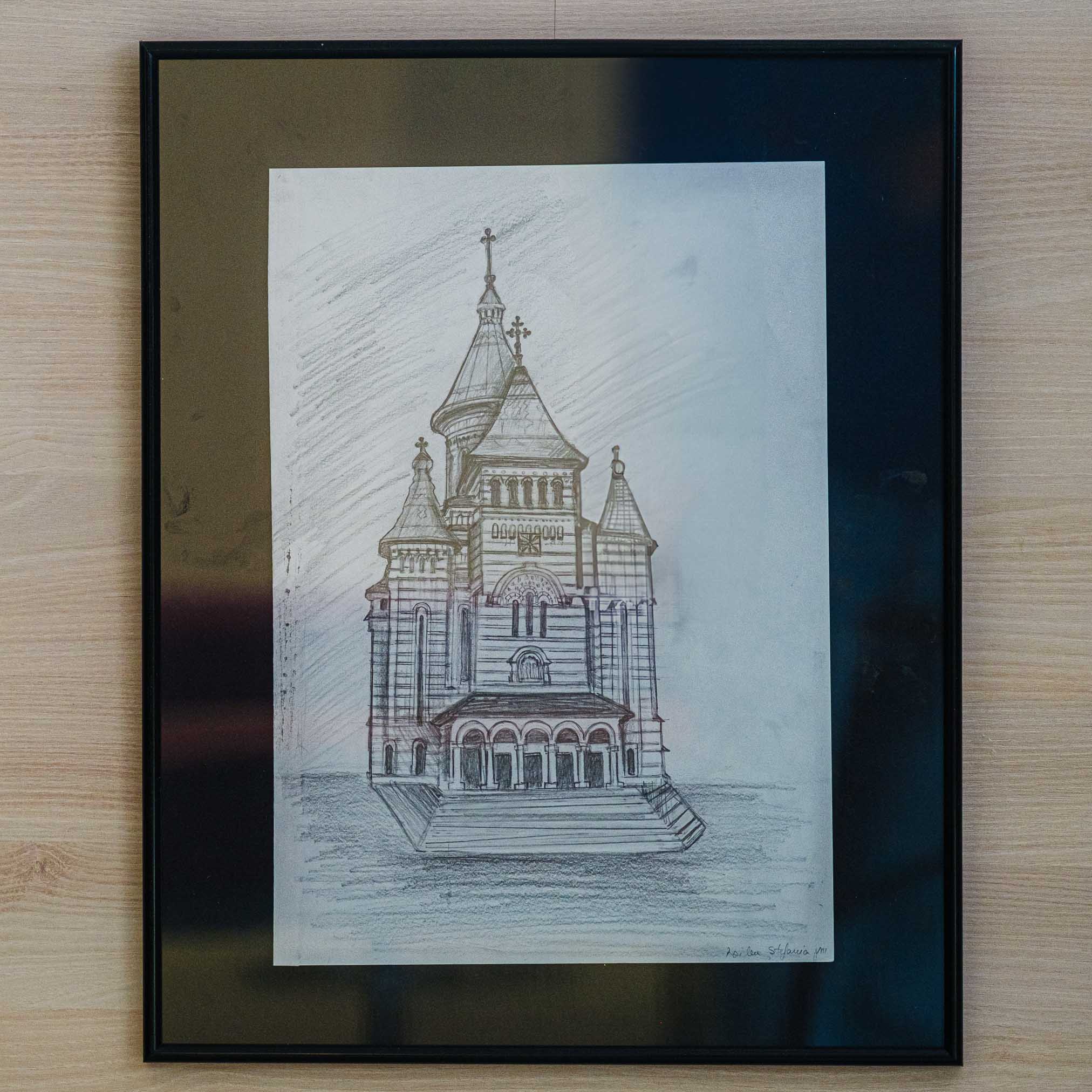
Artwork by Ștefania Roibu, 8th grade A student General School No 19 "Avram Iancu" and exposed to UPT Library within the exhibition "Timisoara's Stories - A Visual Journey through Timisoara" - within the Creative Schools Project - Timisoara's Stories - a continuation of the Spotlight Heritage Timisoara project, part of the cultural program of the Timisoara Cultural Capital 2023 - project that brought together over 1600 children and teenagers and more than 60 teachers from Timisoara's schools, in over 50 interactive activities.
